Introduction: IJN Battleships, from British to Japanese design:
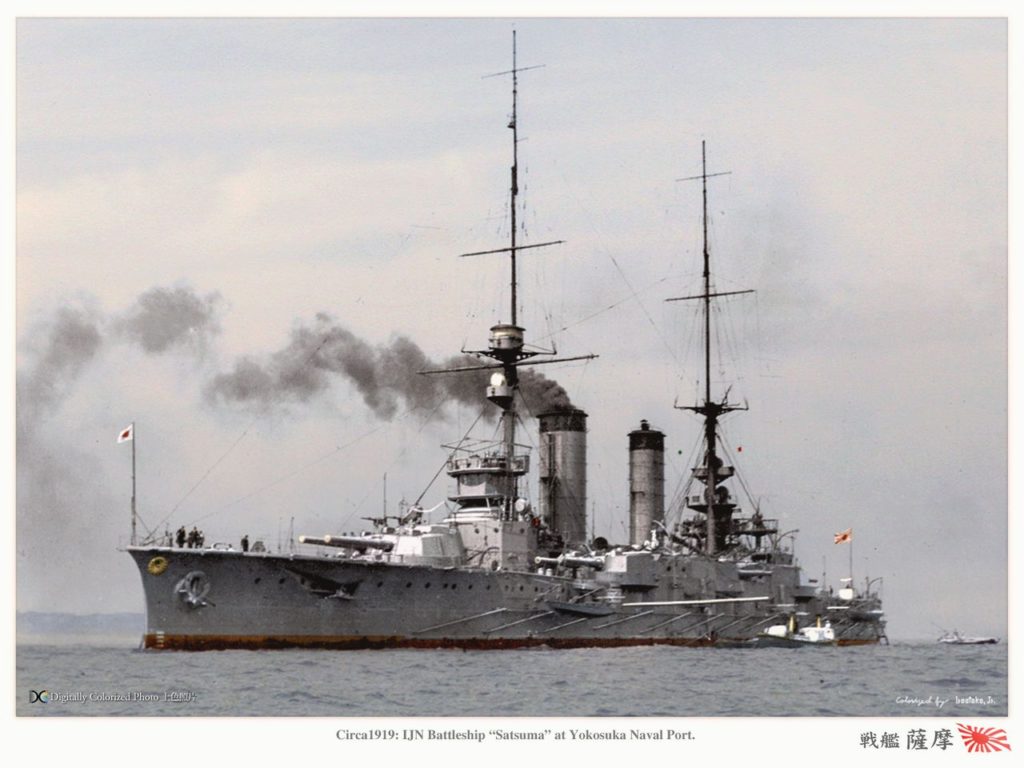
IJN Satsuma, one of the last IJN pre-dreadnoughts. As the other ships of her class she was discarded in 1923.
When Japan entered war in December 1941 on the side of the axis, its land forces, aviation and navy were already fighting in China in a vicious total war since 1937; Its main battle fleet was limited to six battleships and four battlecruisers, which were so well protected after modernization they were in-between the two genres. Like in other navies, they were all of WW1 generation: The four Kongo were not British-built (only the first) but based on a British design and with British assistance, however the Fuso class dreadnoughts were 100% Japanese (designed and built locally) as well as the following Ise class and Nagato. The latter were of a new generation of fast battleships and super-dreadnoughts, completed as the first of the 6-6 or “Six-Six Fleet” ambitious naval plan. The Kaga class battleships and Amagi class battlecruisers were already in construction when Japan signed the Washington treaty.
The treaty put an abrupt stop to all these developments, and although projects studies multiplied in the 1930s, it only crystallized prior to WWI with the most ambitious battleship class ever, Japan choose quality over quantity. When the Japanese Empire entered war against the United States and its allies, for its modernized battlefleet to have a chance, the threat of the USN Pacific fleet was to be eliminated. The only recent battleships were about to enter service at that time, IJN Yamato (December 1941) and Musashi (August 1942). They were part of an ambitious four ships program destined to replaced the Fuso and Ise classes. Just like the Bismarck, they were designed for total supremacy against any opponent.
IJN battleships in WW2: Battle records
The irony was they almost never crossed fire with an American battleship, aviation was their demise, as were submarines for other battleships. The war already changed nature and capital ships were condemned. Three Kongo class were sunk in November 1942, IJN Mutsu in 1943, followed by the two Fuso in October 1944, and the two Ise in July 1945 as well as IJN Haruna, and of course both Yamato class in March and October 1945. IJN Nagato was the only Japanese battleship to survive the war, but not for long. Needless to say, they had a bloody nose during the war, the highest naval losses of the axis. In this article we will see if they were up to the task, how they fared in the rare naval combats they were in, and their main weaknesses: AA and ASW defence.
Modernization of the interwar
We will not dive in detail about the Kongo, Fuso, Ise and Nagato class designs and developments, they all are covered by dedicated posts. Rather we will expand here on the extent and concepts of their modernization: How on earth these vessels acquired such a stereotypical appearance, notably their trademark “pagoda” like structure ? Was their protection reinforced ? Were their machinery modernized ?
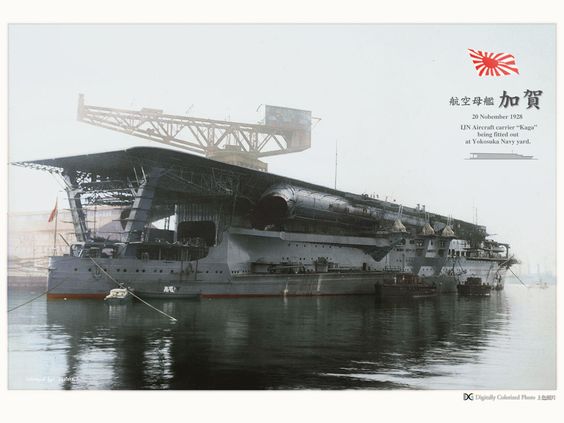
IJN Kaga, just fitting out in 1928 at Sasebo. This Kaga class battleship was the most advanced and completed after launch, as an aircraft carrier. The process started after the signing of the Washington treaty in 1922. The Amagi-class Akagi was also converted after launch for the same reasons. Both conversions were not particularly successful and they underwent many rebuildings and modernization but they became the hard core of Kido Butai.
IJN 8-8 plan capital ships projects
Tosa, Amagi, Kii and N°13 classes (1920-25)
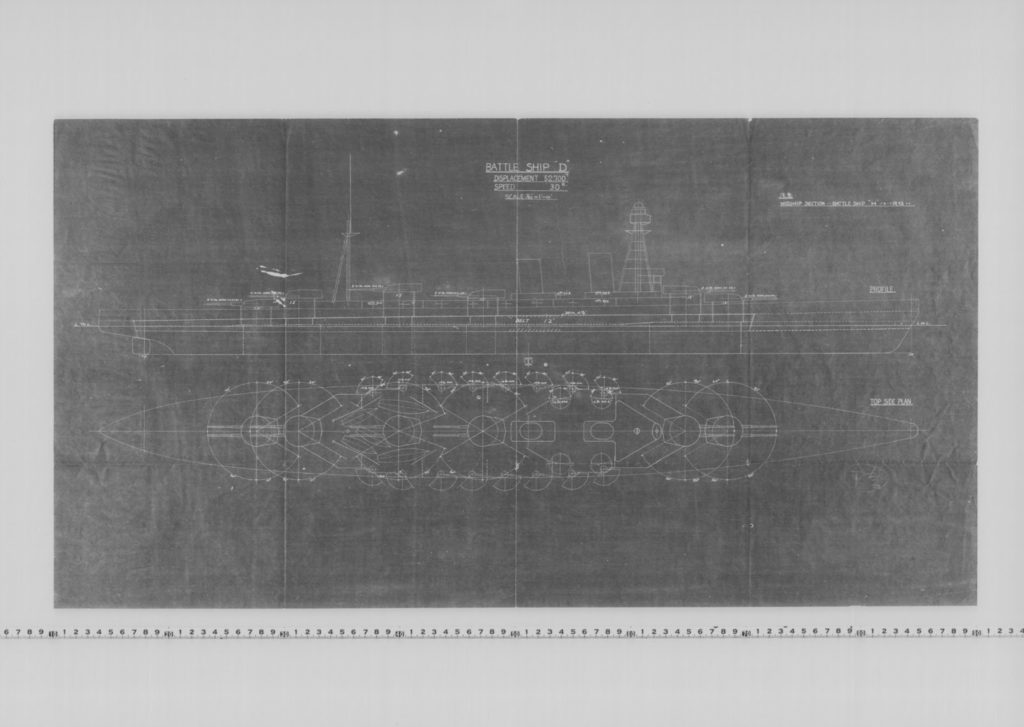
“Battleship D” design 1920, alternative project with ten 406 mm guns. SRC
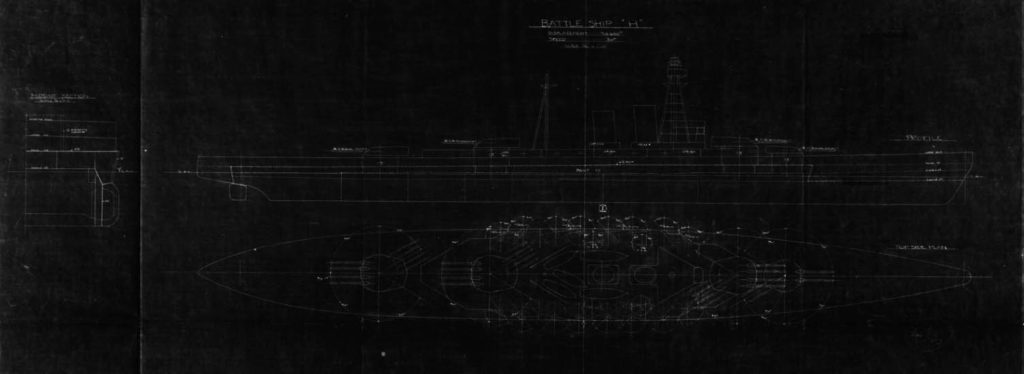
“Battleship H”, alternative project in 1920, credits: Kashiwa Library in The University of Tokyo, JAPAN
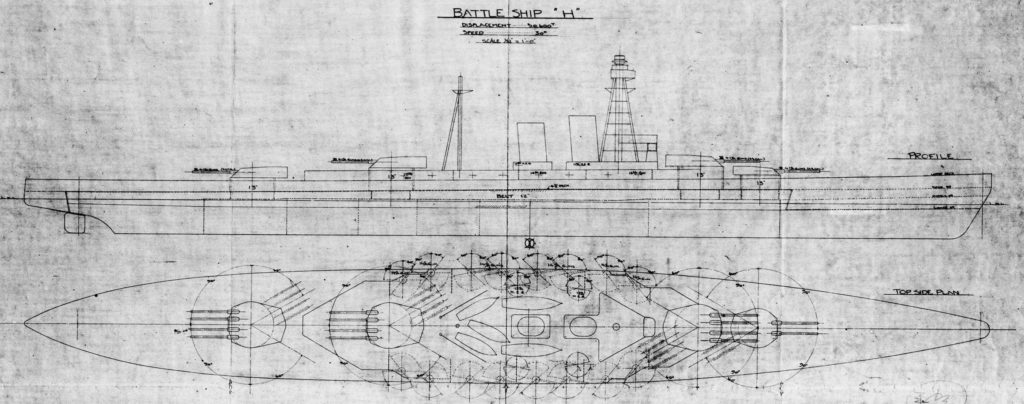
Same, inverted to better see details. This project would have been given no less than three quadruple turrets and one single, unusually the deck level one forward.
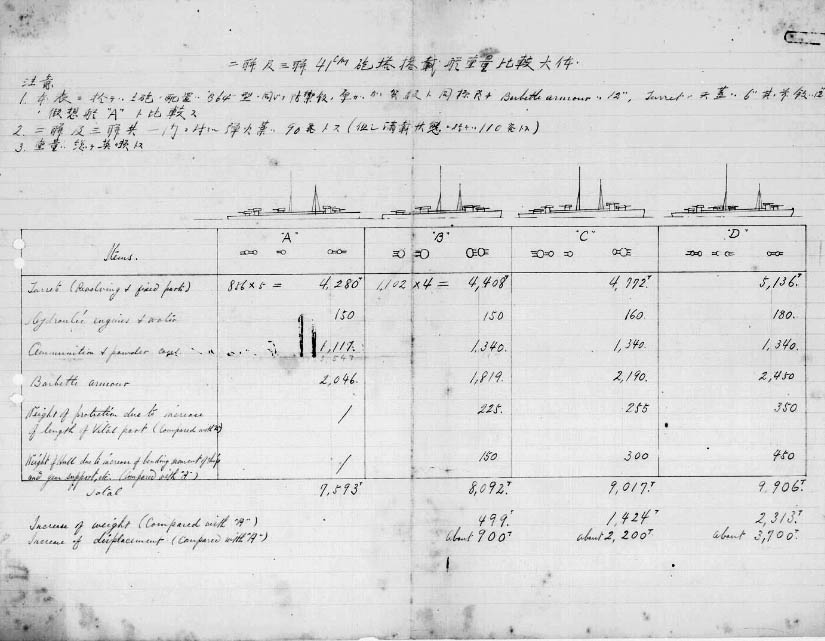
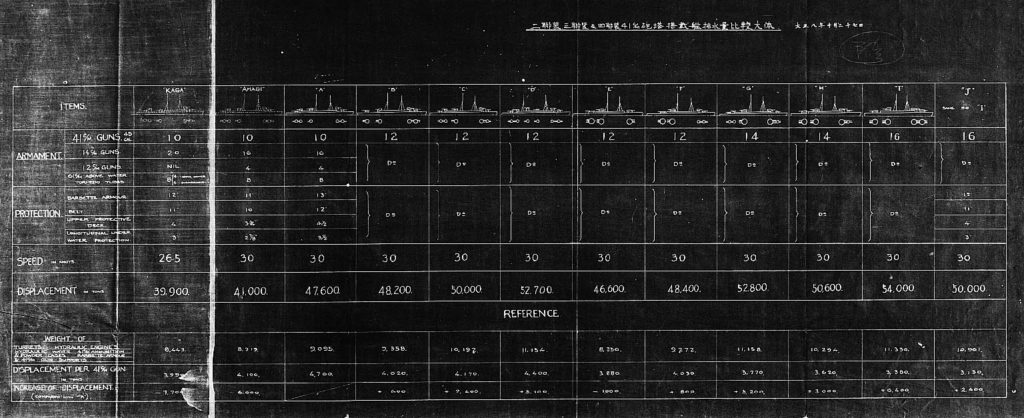
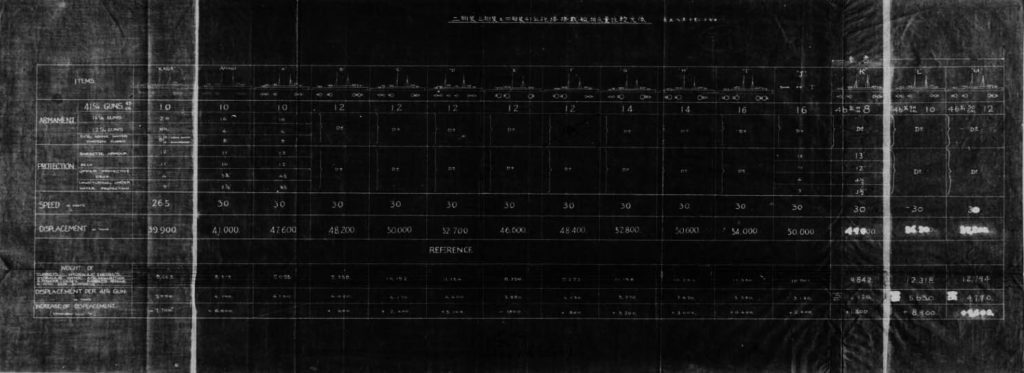
Other 8-8 plan proposals, same source.
Amagi class battleships
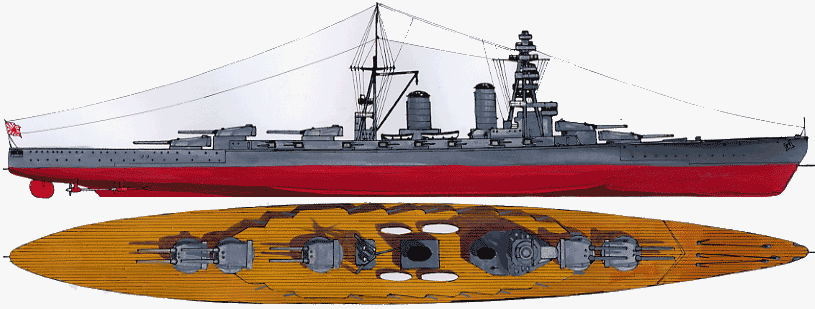
Author’s Amagi class rendition
These four battlecruisers were part of the “Eight-eight fleet” program of the early 1920s. They would have been called IJN Amagi, Akagi, Atago, and Takao. Their design was essentially a lengthened Tosa-class, with a thinner armored belt, weaker deck and more power output for 30 knots (56 km/h; 35 mph), while the secondary armament was rearranged. They carried the same main battery of ten 41 cm (16.1 in) as the Tosa class. On papaer they would have been superior to Hood class. Like the Tosa however, Politicians signed the Washington treaty and due to the tonnage capping, all the ships in constructions were to be scrapped, or converted, as was the IJN Akagi. In fact, both Amagi and her sister-ship were intended to be converted as such but the great Kanto earhtquake in 1924 destroyed the Amagi on slip. She was dismlantled and the Kaga, or the Tosa class was chosen instead to create the two-carriers force the admiralty wanted.
design of the Amagi class
Designed by naval chief engineer of the IJN Yuzuru Hiraga, the Amagi class was named B-64 before any formal name was attributed, first drafted in 1919. The hull was flush deck like the Tosa for rigidity, and the bow still had this caracteristic shape. Planned displacement was 41,217 tonnes (40,566 long tons), up to 47,000 t (46,000 long tons) fully loaded. The hull was 250 m (820 ft) long (waterline) 251.8 m (826 ft) overall, making these the largest IJN capital ship ever built before the N°13.

Propulsion
It should be noted that Hiraga evaluated an alternative design fitted with a diesel-electric propulsion (as for the Tosa), following successful tests of the US Navy. This would have procured only 105,000 hp on paper, less than what was expected to reach the design speed, but a better range of 9600 nm.
They had four propeller shafts and Gihon steam turbines, and no less than 19 Kampon boilers with mixed heating, coal (8) and fuel (11). This overall was credited on paper after calculations of a whooping 131,200 shaft horsepower (97,800 kW) enabling the required 30 knots as designed. Fuel stores amounted to 3,900 tons of oil, 2,500 tons of coal, which procured 8,000 nm range at 14 knots.
Armament
Originally, the design was to carry 16 in/45, but the naval staff asked it was rearmed with the new 16in/50 in development, which was never ready on time. Nevertheless, with ten 410 mm guns, in five twin turret, two in superimposed pairs fore and aft, and one behind them, with a safe margin, aft of the tripod mainmast. Performances of the guns were the same as the Tosa and Nagato, whereas due to the longer hull, the field of fire was arguably better. The secondary battery of sixteen 5.5 in (140 mm) was only reduced compared to the Tosa, it was the same as the earlier Kongo class. The casemate guns were widely spread on the battery deck, reasonably safe from water splashes even in heavy weather. This battery deck was pushed back compared to previous designs, those forward installed at the level of the bridge. The last pair was between the N°3 turret and aft pair. They all had an excellent arc of fire.
The tertiary armament was nothing revolutionary, with four to six (after a revision) 4.7 in/45 AA guns, and eight 24-in tubes (610 mm) above waterline, fixed in the hull, in two broadside pairs fore and aft.
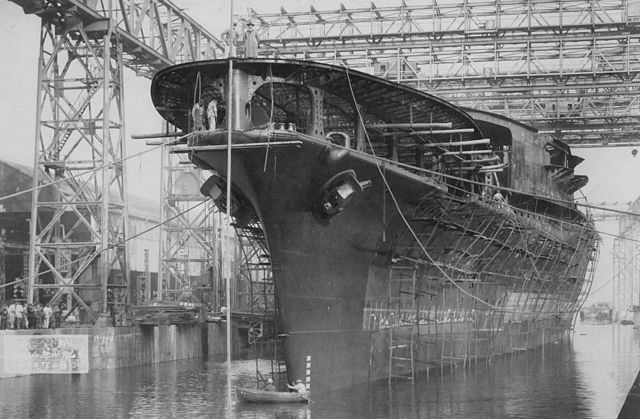
IJN Akagi in 1924
Protection
The scheme was the same as the Tosa, driven by experience from the Nagato, and limited at best to 11 inches, except for the conning tower (14 inches, 356 mm). The Belt was 10 inches only but heavily sloped at 12° so to partly replace the armored deck. There was a torpedo bulkhead 73 mm (2.9 in) thick, barbettes were 230–280 mm (we can suppose the same for the turrets faces) and the deck armor was limited to 95 mm (3.7 in).
Fate of the Amagi class
IJN Amagi was laid down at Yokosuka NYd on 13.10.20, after the Akagi at Kure (6.12.20). This was the first pair. The second was voted FY1921 and laid down late 1921, IJN Atago on 22.11.1921 at Kawasaki and Takao at Mitsubishi on 19.12.1921. That was 100 years exactly from now. Construction proceeded steadily, so much so that the first pair was expected to be launched early to mid-1922, with planned completion dates of November and December 1923 for the first pair, and December 1924 for the second. The Washington Naval Treaty was signed in February 1922, so they were not far from launch. The Amagi class was by agreement, cancelled. There was hope during negociations to convert both the Akagi and Amagi as aircraft carriers, but the signatories decided to cap that tonnage to 27,000-ton per vessel. Given the fact both battlecruisers were way more heavy, practically the displacement of two carriers combined. This would have been a hard target to achieve.
But since the US admiralty was in the same predicament about the Lexington, an optional clause signed by all raised this limit to 33,000-ton (standard). There was hope in that case to be allowed to reach 40,000 tons fully loaded. This handily enabled this conversion, which started right away in early 1922. Some sacrifices would be made allowing the displacement to fall, like removing the very heavy main artillery and some armour. At first, the admiralty considered the Amagi pair the best placed for a conversion, looking at the Lexingtons. Unfortunately, mother nature decided otherwise. The great Kanto earthcake was a traumatic even for the archipelago. This fateful 1st September 1923, Yokosuka was hit hard, and the naval yard was no exception. Part of the griders structure fell on the hull while in final construction before launch. A commission later investigated the damage and concluded that completing her was no longer a viable issue. Stricken and sold, her scrapping started on 14 April 1924. The two others, Atago and Takao were far less advanced. All work stopped but they were not officially canceled before 31 July 1924, and broken up for scrap in their slipways.
The guns of course, were recycled. The Imperial Japanese Army accepted them to be fitted in fortified positions as coastal artillery, three in Tokyo Bay, Busan (Korea) and Iki Island which guarded the strategic Strait of Tsushima. The seven left were placed in reserve, potentially to replace worn-out guns, but eventually scrapped in 1943, such was the need for raw material.
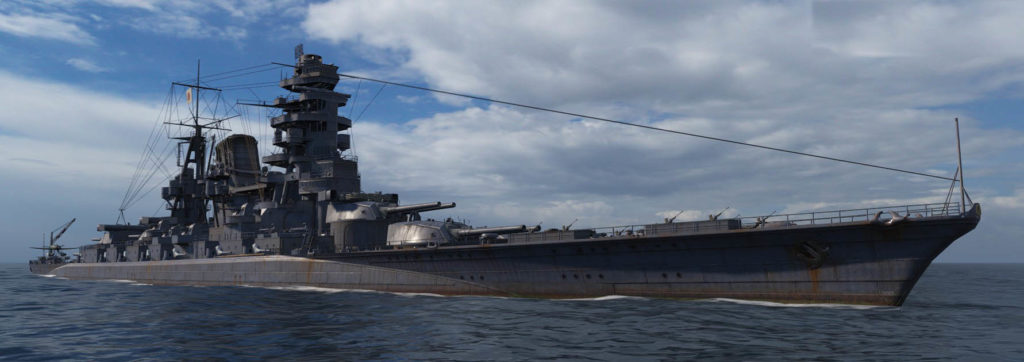
wow’s what-if WW2 rendition of the Amagi class
Specifications (1921)
Displacement: 41,217 t. standard -47,000 tonnes fully loaded
Dimensions: 251.8 m (250 wl) x 30,8 m x 9,5 m fully loaded
Propulsion: 4 shafts Gihon geared turbines, 19 Kampon boilers, 131,200 hp, top speed 30 knots, range 8,000 Km/14 knots
Armour: Belt 254 mm, turrets 230-280 mm, barbettes 280 mm, Bulkhead 73 mm, CT 356 mm, Deck 95 mm.
Armament:10 x 410 mm (5×2), 16 x 140 mm casemates, 4 x 4.7 in AA, 8 TTs aw.
Crew: 1350 (est.)
Tosa class
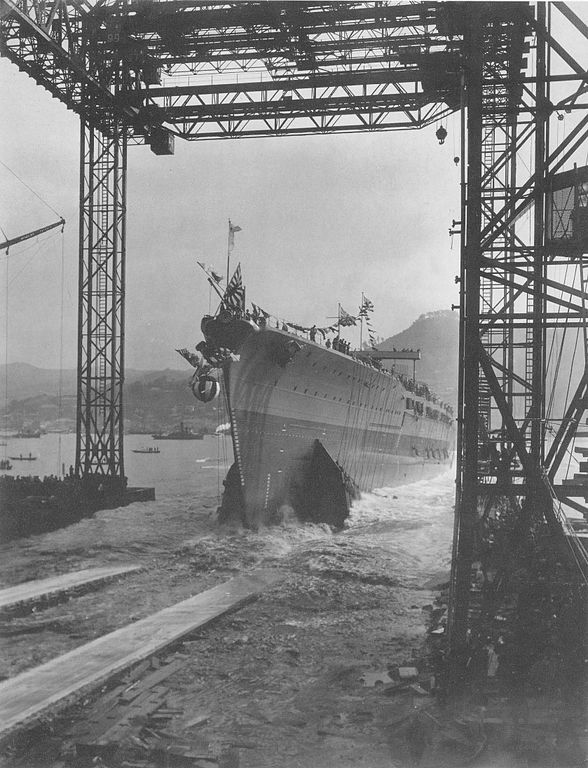
Launch of IJN Tosa at Mitsubishi Yard in Nagasaki, 18 December 1921.
The Tosa-class battleships (土佐型戦艦, Tosa-gata Senkan) were ordered in accordance to the 6-6 plan in 1918, as larger versions of the preceding Nagato, with an additional twin turret with the same 41 cm artillery caliber, placed behind the aft pair on deck level. Construction proceeded at Mitsubishi, Nagasaki and Kawasaki, Kobe, on plans drawn by naval engineer Y. Hiraga. His design included a flush deck in order to strengthen the girders. This was also the first IJN battleship to adopt 24 inches torpedoes. The Tosa were quite impressive battleships: They were much larger than the Nagato, 20 m longer and 40,000 tonnes standard (44,200 FL versus 35,500), arguably better protected (with a big design change, the classic armored deck eliminated) but not faster. The lead designer had time to digest all the battle reports from WWI into this design, as both were started in 1920, on February for Tosa (it’s why the class beared more frequently her name), and July for Kaga. The latter was indeed launched earlier at Kawasaki Yard, by November 1921, and Tosa in December. Some authors (and Conway’s) refers to the “Kaga class” because of this. Both were due to be completed on 25/12/1922 and March 1923 respectively…
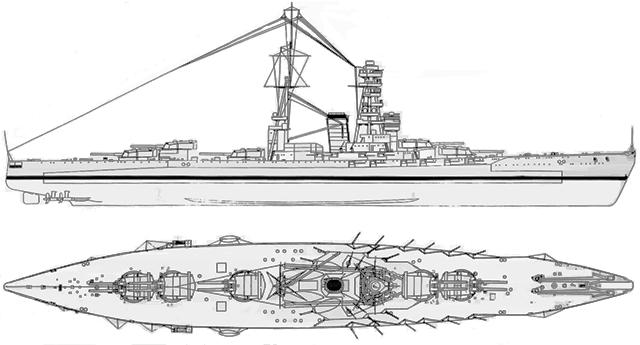
Blueprint reconstruction of the Tosa class
Armament:
The Tosa were basically a repeat, but an extra turret gave them a superior firepower, ten instead of eight 16 in guns (so listed as 406 mm, but 410 mm in reality). This was paid (as fr the armour and top speed) on the balance with nearly 7,000 tonnes of displacement. In addition, they carried twenty 5.5 in (140 mm) in casemates, as the previous BBs, and four 3.1 in AA (78 mm). The initial design planned four underwater and four above TTs, but the underwater ones were later dropped due to high speed, as it was shown the battleship’s mass at such speed could change the course of the torpedoes. Despite Jutland reports now known, that shown that all torpedoes fire during the battle failed to hit anything, the admiralty stood to this obsolete solution.
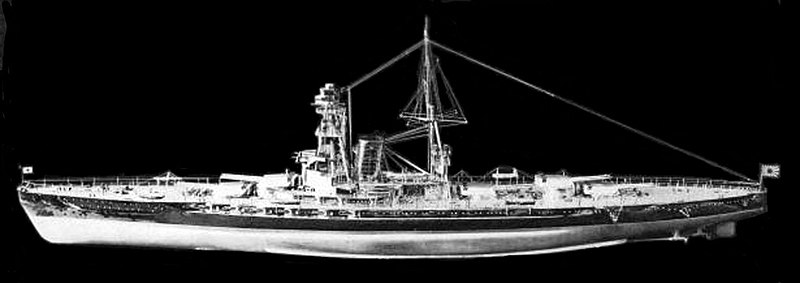
Kawasaki shipyard model of the IJN Kaga
Powerplant:
The design also considered a turbo-electric propulsion like for USN BBs designs, and their own announcements of succesful trials with the New Mexico in 1917. Rejected, the system was nevertheless tested on the oiler IJN Kamoi. The powerplant was about the same as on the Nagato, with four geared Curtis Turbines couples with 12 mixed-fired Kampon boilers (8 oil, 4 mixed), for a total of 91,000 shp, enough for 26,5 knots. To put that in perspective that was faster than British early battlecruisers in WW1. The Tosa class carried 3600 tonnes of oil, 1700 of coal, for 6,400 nm at 14 knots, reduced to 5,000/16 kts and 2,250/26.5 kts. Initial estimations were more optimistic, 7,500 nm at 14 knots.
Armor:
Apart this, Hiraga adopted a well sloped belt armor immune to 16-in shells between 12,000 and 20,000 m. The lower deck armor was virtually eliminated in favor of a heavy flat deck above the belt, roofing it. There was a thin splinter deck below it. The former heavy lower armor deck was indeed replaced in this design by a simple continuation of the inwards sloping 3-in longitudinal torpedo bulkhead (11 inches) connected to the lower edge of the belt proper (11 inches vs. 12 on Nagato) by a short upwards-sloping deck, at 15°. The CT was protected by 14 in walls, better than the 12 in on the Nagato.
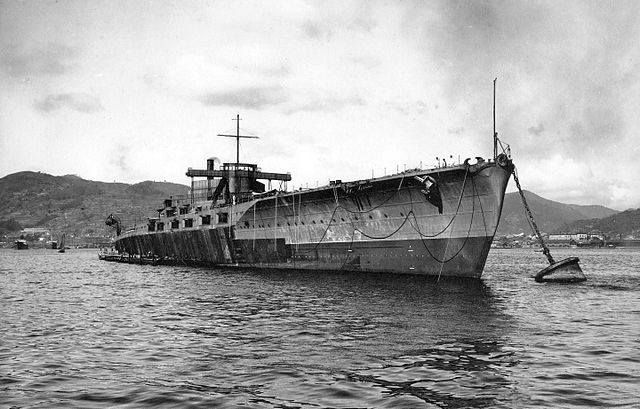
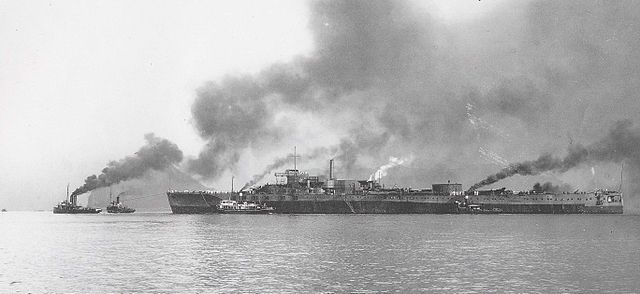
IJN Tosa after launch and towed out of Nagasaki. She was later used as a target ship, and served in this guise until 1925.
After the launch, late 1921 of IJN Tosa the Washington Naval Treaty was signed, and both battleships were to be cancelled due to tonnage limitations, before both could be completed. IJN Kaga was mothballed until reconversion plans were found to convert her as a carrier, but Tosa after her launch was used for testing experiments, notably her armor scheme against shells and torpedoes. She was sunk on 9 february 1925, so after four years as target ship. The hull of IJN Kaga, was converted as an aircraft carrier to replace the Amagi-class battlecruiser wrecked by the Great Kanto earthquake of 1923, initially planned for conversion with Akagi, which would have given two homogenous carriers like the US Lexingtons. IJN Kaga had a long career after reconstructions, in China during the Second Sino-Japanese War, was part of the Kido Butai at Pearl Harbor, the invasion of Rabaul, the airstrike on Darwin and Dutch East Indies campaign, before meeting her fate at the Battle of Midway in 1942.
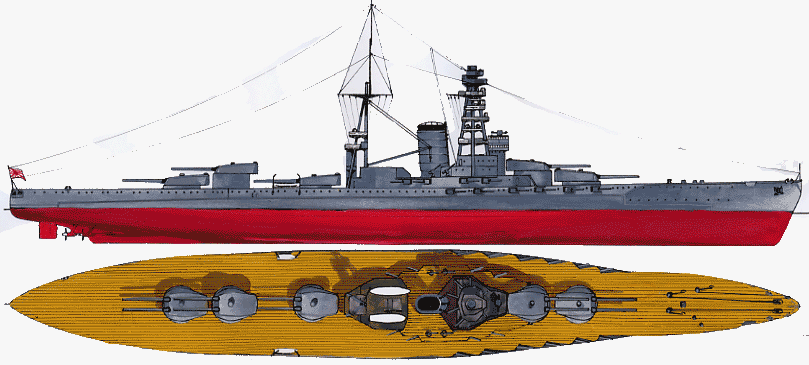
Author’s 2-views illustrations of the Tosa in 1920
Specifications (1921)
Displacement: 39,900 t. standard -44 200 tonnes fully loaded
Dimensions: 231.7 m (218 wl) x 30,5 m x 9,4 m fully loaded
Propulsion: 4 shafts Curtis geared turbines, 12 Kampon boilers, 91,000 hp, top speed 26,5 knots, range 6,500 Km/14 knots
Armour: Belt 280 mm, turrets 250-305 mm, barbettes 305 mm, Bulkhead 280 mm, CT 356 mm, Deck 102 mm.
Armament:10 x 410 mm (5×2), 20 x 140 mm casemates, 4 x 3.1 in AA, 8 TTs.
Crew: 1333
Kii class
Kii, Owari, N°11, 12, ordered Oct. 1921

Rendition of the IJN Kii (unknown author, src pinterest)
The Kii-class was a planned class of four fast battleships which, as defined by the naval staff, merged the two categories of Battleships and Battlecruisers. Only two of the ships received names. They were intended to reinforce Japan’s “Eight-Eight fleet” of eight battleships and eight battlecruisers, after the United States announced the reinitialisation of a major naval construction program in 1919. However, after the signing of the Washington Naval Treaty in 1922, work on the ships was suspended; one pair was cancelled in November 1923 and the other in April 1924. They were designed by Hiraga, and based on the Amagi class, but with a thicker belt and deck armour and later 4.6 inches instead of 3.3/4 inches. They were slightly larger than the Tosa, for twenty meters longer, the same protection, a greater speed, and the same armament as before. The powerplant was way more powerful, combining brand new Gigon turbines to more boilers, for a total output in excess of 130,000 shp. They would probably reached 31 knots on trials, notably because a more favourable lenght/width ratio. The longer hull authorized a greater range, up to 8,000 miles as they carried 3900 tonnes of oil and 2500 of coal. They were “universal capital ships” in the sense they blended both types, forerunners of the fast battleships of the late 1930s.
Of course, they were cancelled because of the Washington treaty, none being laid down. Nevertheless, at nearly 50,000 tonnes, as much as the Bismarck, and the speed to match, they would have been formidable adversaries if completed in 1925-26, and modernized in WW2.
Known Specifications (1921)
Displacement: 42,600 t. standard -48,500 tonnes fully loaded
Dimensions: 250 m (234.8 wl) x 30,8 m x 9,7 m fully loaded
Propulsion: 4 shafts Gihon geared turbines, 19 Kampon boilers, 131,200 hp, top speed 29,75 knots, range 8,000 Km/14 knots
Armour: Belt 292 mm, turrets 230-380 mm, barbettes 280 mm, Bulkheads 73 mm, CT 356 mm, Deck 120 mm.
Armament:10 x 410 mm (5×2), 16 x 140 mm casemate, 4-6 x 105 mm (4.7 in) AA, 8 610mm TTs.
Crew: 1380 (est.)
N°13 class
N°13, N°14, N°15, N°16 (planned laid down 1924)

The Number 13-class battleship were four fast battleships to be built after the Kii class during the 1920s. They never received any names, only numbered N°13–16, intended to reinforce the “Eight-Eight Fleet” after US announcements in 1919. The Number 13 class were pure naval superiority battleships, and they embodied the concept behind the Yamato but in the 1920s already, and were planned to take a lead that would not be contested for a decade and more. The signing of the Washington Naval Treaty doomed any prospect of approval and the program was cancelled in November 1923, before orders could be given to, respectively, Yokosuka, Kure, Mitsubishi and Kawasaki. What would have they been like ?
They measured 259.1 meters (between perpendiculars), 274.4 meters (900 ft 3 in) overall, ten meters more the future Yamato and even more than the Iowas of 1944 (270 m). Their “waist” was nimble however at 30.8 meters (101 ft 1 in) for 9.8 meters (32 ft 2 in) of draft (vs 39 m and 33 m for Yamato and Iowa). This was still a “thin” design, for two reasons: With the powerplant available, reducing the lenght-to-width ratio was a way to achieve a better speed, whereas ASW protection was still relatively light at the time.
Confirming this, normal displacement was 47,500 metric tons (46,700 long tons), and probably 55,000 FL, versus 71,659 LT FL and 57,540 LT FL for the Yamato and Iowa. But on paper, she was indeed the largest battleship ever designed for the IJN until the Yamato that took the same concept on a more updated version in 1935-39.
The N°13 class was receving four Gijutsu-Hombu geared steam turbines, a brand new tailored model, the most powerful ever designs in Japan so far. Each drove a single propeller shaft, and together they were designed to produce 150,000 shaft horsepower (110,000 kW), fed by the hot steam coming from 22 Kampon oil-fired water-tube boilers, more than any other IJN design to that point. This maelstrom of torque was to provide 30 knots (56 km/h; 35 mph). So she was also a battlecruiser, or to summup the vision of the admiralty at that time, a “universal battleship” capable of performing both roles. She simply was a fast battleship.
Primary armament ws probably their most facinating aspect. They were given eight 50-caliber guns, less than previous class, but this was to leap towards the next generation: 460-millimeter guns (18 inches) in four twin-gun, two pairs fore and aft superfiring. The development of this gun was started during the tile the Washington treaty was already in discussion, so none was ever manufactured. As planned, they were to fire a 1,550-kg (3,420 lb) shell at 800 meters/second (2,600 ft/s). The secondary battery was not innovative, it was the same 16 single 140 mm/45 (5.5 in) guns casemated in the superstructure, like the previous Amagi class. They were all manually operated and reached 19,750 m (21,600 yd) at +35°, 10 rpm. The anti-aircraft defense was standard for the time, eight 120 mm/45 (4.7 in) guns grouped around the single funnel. Eight 610 mm (24 in) torpedo tubes were also provisioned, in two groups fore and aft on the broadside hull.
Protection was not equal to the firepower, as a compromise to keep the top speed. The belt was indeed only 330 mm (13 in) thick, but angled at 15° outwards to alleviate the need for a classic armoured deck. It was designed to stop penetration at short range and deflect shells entering at high angles. The deck armor eached 127 mm (5 in). Other specs are not known with precision, but we can guess: The CT would have been probably 14 in thick (356 mm) and the barbettes 330 mm (13 in), like the turrets faces. This relatively “light” armour was still better than for a standard battlecruiser, which was the classification retained by Conways, while other authors classed her as a battleship. She was both, and the need for armour was less urgent as their main guns were designed to outrange the enemy, so staying out of harm. Some renditions
Known Specifications (1921)
Displacement: 47,500 t. standard -circa 52-55,000 tonnes fully loaded
Dimensions: 274.4 m (259.1 wl) x 30,8 m x 9,8 m fully loaded
Propulsion: 4 shafts Gihon or Gijutsu-Hombu geared turbines, 22 Kampon boilers, 150,000 hp, top speed 30 knots, range: circa 8,000 Km/14 knots
Armour:Belt 330 mm sloped 15°, Deck 120 mm.
Armament:8 x 460 mm (4×2), 16 x 140 mm casemates, 8 x 120 mm (5.5 in) AA, 8 x 610 mm TTs.
Crew: 1400 (est.)
Interwar reconstructions (1925-38)
Like other nations, the Washington treaty did not precluded the modernization of authorizes, existing capital ships. Therefore the IJN gradually modernized and improved its battlefleet during the Interwar, sometimes with radical reconstructions to the scale of the Italian refits. Such were the Kongo class, by far the most impressive. For all, the idea was about the same same: Changing the ageing powerplant for a more modern and efficient one, reaching a greater power in order to cope wit additional armour. The latter integrated lessons from WWI, reinforcing ASW protection against submarines and vertical surface against aviation. In addition, the fire control systems were modernized, main guns mounts changed to reach a greater elevation and thus, range, combined with sometimes rebored guns, or modern shells with more explosives; Also AA, which generally included a few 3-inches guns, gradually improved with dual purpose 5-inches and batteries of 25 mm guns and 13 mm heavy machine guns, long derivative of prewar Hotchkiss air-cooled models scaled up. It should also be precised that Japan retired from the London treaty discussions and never ratified them, giving Japanese engineers more flexibility in the scope of their modernization (as well as enabling more freedom for fast battleship projects).
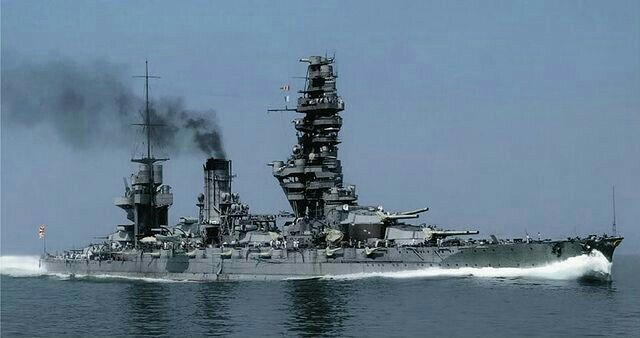
IJN Fuso, showing the tallest bridge superstructure ever seen on a warship.
Kongo class reconstructions:
-In 1924, the first wave concerned the fire control and main-gun elevation, and increased AA armament.
-In 1929, armour was massively improved, powerplant and machinery space modernized to keep pace, and aviation. In 1931 she was reclassified as a battleship, as the other three of the class.
-In 1935, the second large reocnstruction started, mostly aimed at modernizing the secondary and AA artillery, but also complete her pagoda bridge, vaslty improved boilers and turbines for 30 knots (35 mph; 56 km/h) – so now these battlecruisers were fast battleships, and reconfiguration of aircraft catapults. When this phase ended in 1937, they were state-of-the art surface combatants, faster than any other capital ship in Asia, with 356 mm guns, retaining some 8-inches, and with a powerful AA.
-New wartime modifications included vastly more AA, and radar around 1944.
Fuso class reconstructions:

Fuso 1928
-1917: New FCS installed
-1923: 8-meter (26 ft 3 in) telemeters installed. Aviation installed in 1922.
-1933 (1st reconstruction): New AA directors, new rangefinder installed, 127 mm (5.0 in) DP guns installed, foremost 6-in casemated guns removed. Six new Kanpon oil-fired boilers and four geared Kanpon turbines installed for 75,000 shp (56,000 kW) and 24.7 knots (instead of 23). Quadruple 13.2 mm (0.52 in) HMG and twin 25-millimeter (0.98 in) gun mounts installed. Deck armor increased, longitudinal bulkhead added.
-1944: Second reconstruction: Mostly FCS and in 1943, 17 single, 2 twin-mounts added. 95 x 25 mm (1 in) AA guns added in August 1944(23 single, 6 twin, 8 triple mounts).
AA gun exhibited excessive vibration and magazine was too small while excessive muzzle blast blinded the servants. IJN AA proved troublesome and inneficient, notably because the relatively slow reload and it was labor intensive.
Ise class reconstructions:
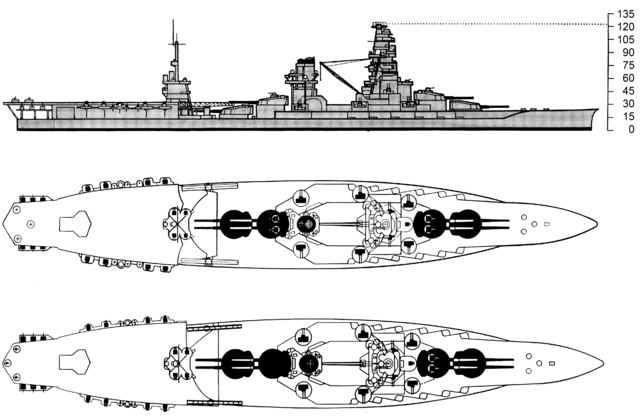
-New FCS 1924
-1930s: 8 Kampon oil-fired boilers, 8 Kampon turbines, 80,000 shp and 24.5 knots (45.4 km/h; 28.2 mph) (25.26 knots trials), fuel storage increased, new DP 5-in AA, some 6-in deposed, new AA, FCS upgraded in additional platforms, new directors for the 12.7 cm AA guns, then new main FCS, directors for the 25 mm, new 10 m rangefinders. No apparent armour upgrade but ASW protection, larger hull.
-1942: More AA, Type 21 air-search radars installed
-1942 conversion: This was a complete reconstruction as hybrid battleship/aircraft carriers. 70-metre-long (229 ft 8 in) flight deck installed aft, hangar, 22 seaplanes, 2 catapults, but also
Type 21 air-search radar, Type 13 early warning radars, Type 22 surface-search radars and final AA armament of 16 5-in DP guns 31 × 3 + 11 x 25 mm AA, 6 × 30-rds AARL.
Nagato class reconstructions:
1924-26: 3 seaplanes installed and catapults, new AA, new FCS, new AA directors.
1934-36: Stern lengthened, forward superstructures rebuilt (full pagoda mast), torpedo bulges, additional vertical armor, overall length of 224.94 m (738 ft) for 34.6 m (113 ft 6 in) beam, 7,000 metric tons (6,900 long tons) increase in displacement. Belt now 100–305 mm (3.9–12.0 in), decks 51–152 mm (2.0–6.0 in) and barbettes: 376 mm (14.8 in), some 14 cm guns removed, four twin 12.7 cm (5 in) DP guns added, extra 25 mm (1 in) AA guns.
-1942-44: Extra AA up to 98 x 25 mm, Type 21 air search radar, Type 13 early warning radars, Type 22 surface search radars installed.
Armament of IJN capital ships
Main artillery
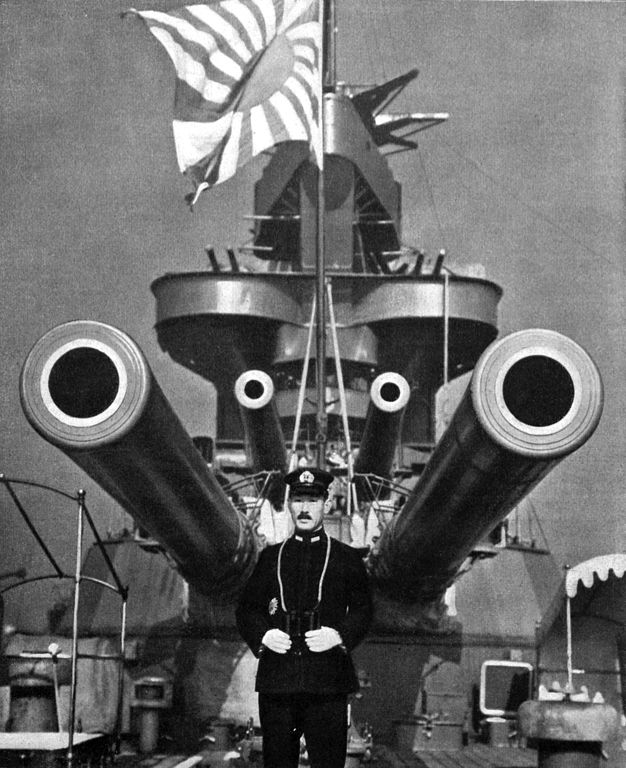
IJN Yamashiro’s main guns
14 inches/45 (35.6 cm) Vickers
The Kongo class battlecruisers, Fuso and Ise class battleships, were all given these guns, so in total 80 guns plus spares, so 100 in total as stated by Kure Arsenal and by Japan Steel Works, LTD archives. They were also given locally in IJN ordnance 45 caliber 41st Year Type 36 cm Gun. They were also known in UK as the “Mark A”, and in Japan 41st and 43rd Year Type. It was considered the best IJN battleship gun, designed at Vickers Barrow in 1910 but built in Japan, and considered quite accurate and reliable.
The barrel was made of the full-length wire wound type, using cannelured rings at the tube shoulders. It also used the Vickers “pure couple” breech mechanism and Welin block.
Each gun weighted 189,586 lbs. (86,000 kg) and fired from 1925 the APC Type 5 of 1,400 lbs. (635 kg), and in WW2 the APC Type 91 of 1,485 lbs. (673.5 kg), the Common Type 0 HE of 1,378 lbs. (625 kg) and the Common Type 3 IS of 1,371 lbs. (622 kg).
40 cm/45 (16.1 inches) 3rd Year Type
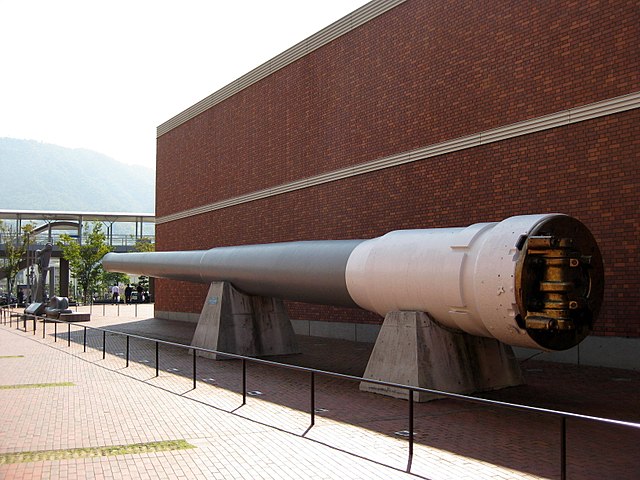
Mutsu’s preserved 41cm/45 3rd Year Type naval gun at the Yamato Museum.
Also called 41 cm/45, this gun was a major step forward, entirely designed and built in Japan, at Kure arsenal. Officially called 45 caliber 3rd Year Type 40 cm Gun it was planned in 1913 already, and development started in 1914. It was tried and entered service in 1921, quite a long delay showing that designing a new gun, even in times of was, is not a quick process.
The first ships planned with these were the Nagato class dreadnoughts, completed in 1920-21. But a hundred were planned for the following Kaga, Amagi and Kii classes, of battleships and battlecruisers, all cancelled because of the Washington treaty. The extra guns (40 were manufactured at Kure, Muroran Ironworks in all), 41 cm models were later used to upgrade the Nagato in 1930, the others went in various fortifications at the southern entrance to the Sea of Japan. Similar in construction as wire wound guns they were lighter, notably compared to the British 15-in (381 mm). They also differed as using a Welin screw breech with an Elswick 3-motion short-arm mechanism.
These guns weighted 100 tons (101.6 mt) and fired several types of ammunitions: In the interwar, the APC Type 3, 5 or 6 of 2,205 lbs. (1,000 kg) and in WW2, the APC Type 91 of 2,249 lbs. (1,020 kg), Common Type 0 HE of 2,069 lbs. (938.5 kg) ad the Common Type 3 IS of 2,072 lbs. (940 kg) and Illumination round, and more famously the Type 3 Sankaidan incendiary AA shrapnel shell, used with success during the pacific campaign.
40 cm/45 (15.7 inches) Type 94
These guns were studied in the interwar especially for the Yamato class battleships. Design work commenced in great secret in 1933, and it was modelled after the American and British 16-inches, but in reality was studied to surpass them in range an penetrating power for a good reason: Their true caliber was of another magnitude than the official figure: Called the 45 caliber Type 94 40 cm Gun it was in fact a 46 cm (18.1 inches) and therefore entered the history books as the largest guns ever fitted onto a ship. The Yamato class were designed for clear-cut naval superiority over any opponent. The power of this gun was indeed unsurpassed. In 1938 testings it was found the blast exerted a pressure of 7.0 kg/cm2 (100 psi) 15 m (50 feet) in front of the muzzle, twice as much as Nagato’s main guns.
These formidable guns, which veritable size and caliber were discovered well after WW2 (US intel assumed they were 16-in guns), were used by Yamato at Battle off Samar with AP shells in October 1944 and Musashi with AA schrapnel shells at the Sibuyan Sea. At max elevation of around 40 km range, 440 to 550 yards (400 to 500 m) of dispersion was observed. 27 in all were built by Kure arsenal. It entered service in 1939. Two guns were captured and tested in the US after the war.
These were not only heavy but also very complex to manufactured and costly guns. The A tube had a 3A tube shrunk on half the length from the breech end withwire-wound with a layer of two tubes shrunk for the entire length and two-part jacket up to the the breech. Belleville spring washers were fitted to lessen stress concentration. The inner A1 tube was radially expanded by hydraulic pressure, applied in three separate operations and rifled when in place. A Short breech ring and bush was screwed into the 3A tube. The Absurby-type breech had a Welin breech block.
Instead of being relined and rebored it was found more simple the replace the gun entirely. Each gun weighted an amazing 363,000 lbs. (164,654 kg).
It fired three types of ammunitions: The APC Type 91 and type 1 of 3,219 lbs. (1,460 kg), Common Type 0/ Type 3 HE of 2,998 lbs. (1,360 kg) and the AA shrapnell shell (see below).
A 46 cm shotgun: The Common Type 3 Sankaidan Anti-Aircraft Shell
Yamato and Musashi, just as Nagato and Mutsu, were provided with a special anti-aircraft incendiary shrapnel shell. In the ordnance it was called 3 Shiki tsûjôdan or Common Type 3, weighing 2,998 lbs. (1,360 kg). It was was filled with 900 incendiary-filled tubes and set by a time fuze to the desired bursting altitude, generally around 1,000 meters (1,100 yards) after being fired. Theses incendiary made a 20 degree cone while the shell itself was blasted by another charge to add more splinters. The incendiary tubes burned for five seconds at 3,000 degrees making a 5 meters (16 feet) long flame. But apart a few shrapnells, this was considered merely as a light show by USN pilots that just went through unscaved more of the time. It never has been an effective AA weapon.
Other main gun projects
-31 cm/50 (12.2″) Type 0, planned for the B-65 class heavy cruisers. Studied from 1940 they were cancelled after the battle of Midway. Little is known but their ammunition, the AP shell of 1,265 lbs. (561 kg) with a bore length of 610.2 in (15.500 m) and potential rate of fire of 3 rpm. The whole design was furiously close to the USN Alaska class.
-46 cm/50 (18.1″) 5th Year Type (1921), project for the 8-8-8 naval plan, cancelled with the Washington treaty
-36 cm/45 (14.2″) 5th Year Type, cancelled in 1921 but tested again at Kamegakubi proving grounds in secret in 1935-36. It was in reality a 480 mm caliber (18.9 inches).
-51 cm/45 (20.1″) “A” Type 98 – The last heavy main gun ever studied by Japan, planed for the “super yamato” 90,000 tonnes class of 1944-45. Two guns and one gun mount were ordered from Kure Navy Yard in June 1941 but assembly never took place and they were discovered in parts in 1945. These superlative ordnance pieces would have weighted 223.4 tons (227 mt) with breech mechanism, and a potential 50 km range, with a two tons shell.
Secondary artillery
-20 cm/50 (7.9″) 3rd Year Type More
-6″/50 (15.2 cm) Vickers Mark M – More
-5.5″/50 (14 cm) 3rd Year Type – More
DP artillery
-12.7 cm/40 (5″) Type 88/89 More
-10 cm/65 (3.9″) Type 98 More
AA artillery
-3″/40 (7.62 cm) 41st Year Type – More
-40 mm/62 (1.575″) “HI” Type 91 – More
-25 mm/60 (1″) Type 96 Model 1 – More
-13 mm/76 (0.52″) Type 93 – More
-7.7 mm/94 (0.303″) “HI” Type – More
Onboard aviation
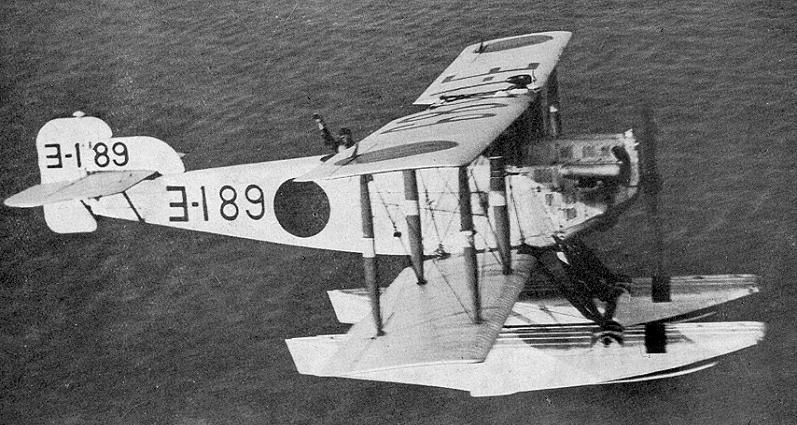
-Yokosuka E1Y 1926 reconnaissance seaplane
-Nakajima E2N 1929 reconnaissance seaplane
-Nakajima E4N 1930 reconnaissance seaplane
-Kawanishi E7K
-Nakajima E8N “Dave”
-Mitsubishi F1M “pete”
-Aichi E13A
-Aichi E16A ‘Zuiun’
Read More/Src
https://en.wikipedia.org/wiki/Six-six_fleet
conway’s all the world’s fighting ships 1906-21 & 22-47
The Ships That Never Were, a Collection of Cancelled Naval Projects 1918-1922 by Peter A Marshall
http://www.hazegray.org/navhist/battleships/ijn_dr.htm
Evans, David C.; Peattie, Mark R. (1997). Kaigun: Strategy, Tactics, and Technology in the IJN 1887–1941.
Garzke, William H.; Dulin, Robert O. (1985). Battleships: Axis and Neutral Battleships in World War II.
Jentschura, Hansgeorg; Jung, Dieter; Mickel, Peter (1977). Warships of the IJN 1869-1945.
Lacroix, Eric; Wells, Linton (1997). Japanese cruisers of the Pacific War.
Jackson, Robert (2000). The World’s Great Battleships. Brown Books.
Johnston, Ian & McAuley, Rob (2000). The Battleships. MBI Publishing Company.
Lundgren, Robert (2014). The World Wonder’d: What Really Happened off Samar. Nimble Books.
Mizuno, Hiromi (2007). Lunning, Frenchy (ed.). “When Pacifist Japan Fights: Historicizing Desires in Anime”.
Reynolds, Clark G. (1968). The Fast Carriers; The Forging of an Air Navy. McGraw-Hill Book Company.
Skulski, Janusz (2004) [1988]. The Battleship Yamato: Anatomy of a Ship Conway Maritime Press
Spurr, Russell (1981). A Glorious Way to Die: The Kamikaze Mission of the Battleship Yamato, April 1945. Newmarket Press.
Steinberg, Rafael (1978). Island Fighting. Time-Life Books Inc.
Steinberg, Rafael (1980) Return to the Philippines. Time-Life Books Inc.
Wheeler, Keith (1980). War Under the Pacific. Time-Life Books.
Whitley, M. J. (1999). Battleships of World War Two: An International Encyclopedia.
Willmott, H.P. (2000). The Second World War in the Far East. Wellington House.
Yoshida, Mitsuru; Minear, Richard H. (1999) [1985]. Requiem for Battleship Yamato.
Nomenclature of IJN battleships
Kawachi class battleships (1911)

The Kawachi and Settsu were the first dreadnoughts built in Japan. They were built in Yokosuka Naval Arsenal and Kure Naval Arsenal, partly on British plans and typical in their configuration for the time, with six twin turrets: Two fore and aft, in the axis, and four side turrets. We will not dig in detail on these as they are treated in the WW1 Japanese battleship article already. What we are interested about is their fate after the end of WW1. IJN Settsu in fact did not saw the end of the war: On 12 July 1918, she was lost after an accidental magazine explosion in Tokuyama Bay. This was a tragedy that cost the ship over 600 crewmen. Naturally, she was a total constructive lost, Stricken from the list on 21 September 1918. Her wreck was later partially dismantled and the rest served as an artificial reef.
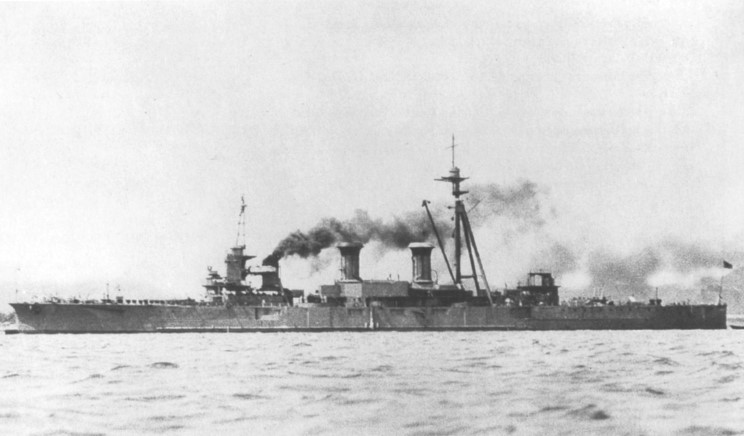
IJN Settsu however had a longer career: She was first reboilered and modernized in 1919-1921, but disarmed and later converted according to the Washington treaty in 1922, to a target ship. While her guns were reused in several coastal artillery positions and fortifications, notably in the Tsushima strait, her hull was reinforced to withstand hits and most of her superstructure torn down. She kept that role from 1924 until 1935 and then was converted into a radio-controlled ship, becoming a moving and evoluting target.
She even received additional armor, notably over the deck. She still could be manoeuvred manually, and so during the second Sino-Japanese War in 1937, she carried a battalion of naval troops to the Shanghai. IJN Settsu also simulated the radio traffic of eight aircraft carriers in December 1941 to deceive Allied intelligence. She then became a target for carrier pilots. In July 1945 she was anchored in Kure when she was attacked by waves of bombers, badly damaged and forced to beach. She was stricken from the Navy List in November that year, her hulk was raised and scrapped in 1946–1947.
Kongo class battlecruisers (1912)
 Japan, 1912. Kongo, Kirishima, Hiei, Haruna.
Japan, 1912. Kongo, Kirishima, Hiei, Haruna.
The last Japanese capital ships built in UK
The Kongo class were started as battlecruisers on paper back in 1911, and the lead ship was the last built in the United Kingdom. That habit that started in 1890 and then continued after the success of Tsushima ended there. These were battle cruisers, a type then at the tip of all expectations in 1912. But these four ships ordered by the Japanese Admiralty in 1911 to various yards, also differed significantly from British equivalents.
In general it was recognised they had a certain resemblance to the three “Princess Royal” built at the same time. The three uneven-sized funnels, square bow and the pointed, tapered stern, the offset C and D turrets, were all similar, as was the relatively weak submarine and overall protection. All four ships were ready on time to see the Great War, but their career had nothing memorable to offer. For more on this, see the WW1 section about these ships.
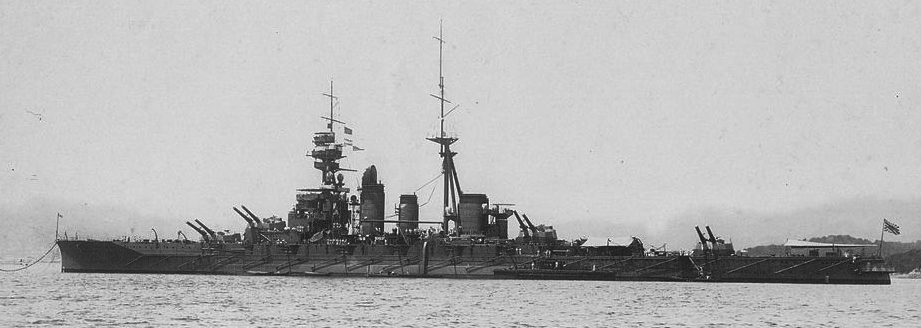
Hiei at Sasebo NyD 1926
From battlecruiser to fast battleships
Fortunately for the Japanese, the admiralty undertook in 1925 to strengthen this protection. The first two ships, Kongo and Haruna were actually delivered by two British shipyards, launched in 1912 and completed in 1914, with Armstrong guns. But the Hiei and Kirishima were built and completed in Kure, a yard just freshly upgraded with new drydocks capable of housing such massive capital ships, the largest on record. In 1914, when these last two ships were completed, the class was the most impressive lot of the Pacific.
The Americans then had nothing to compete. If their 32 knots top speed and eight 356 mm broadside volley to 20,000 meters range was not impressive enough their secondary armament was complemented by an impressive barbette battery of 18 cruiser caliber artillery and a superstructure bristling with quick-firing anti-torpedo boat guns.
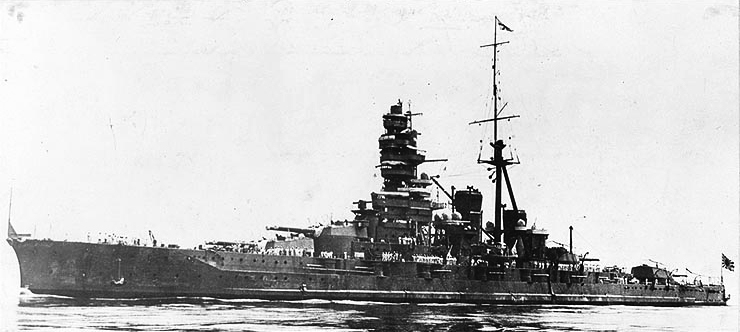
Kongo after her first reconstruction
Second reconstruction (1928-31)
From 1928 until 1931, all four ships underwent a thorough reconstruction. It was total and concerned virtually everything from the keel to the masts, propulsion to armament, superstructures to armor. The first priority was to increase armor while taking advantage of the modernization of their propulsion system, using oil for a net gain in internal space. An elongated hull helped to keep speed up despite the tremendous added weight.
In fact, even after a considerable reinforcement of their protection, and nearly 10,000 tons more on the scale, they were still capable of 26 knots, definitely reclassed in the brand new category of “fast battleships”. Later on a second powerplant refit made them regain a top speed of 30,5 knots.
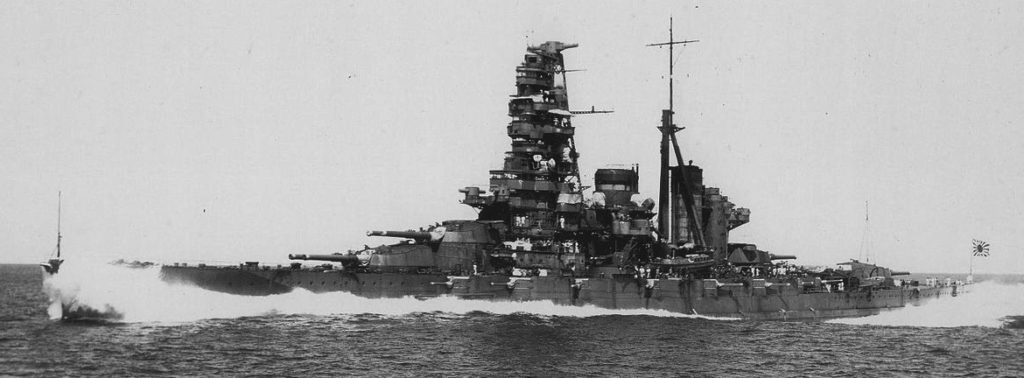
Battleship Haruna in 1934
One of their most characteristic sign after this modernization was their trademark and imposing “pagoda”, a gradual assembly of bridges around the front tripod mast, which remained relatively reasonable in height, mainly for reasons of stability. But this approach also taken by partly modernized battleships of the Queen Elisabeth class went off as three of these battleships superstructures were totally modernized.
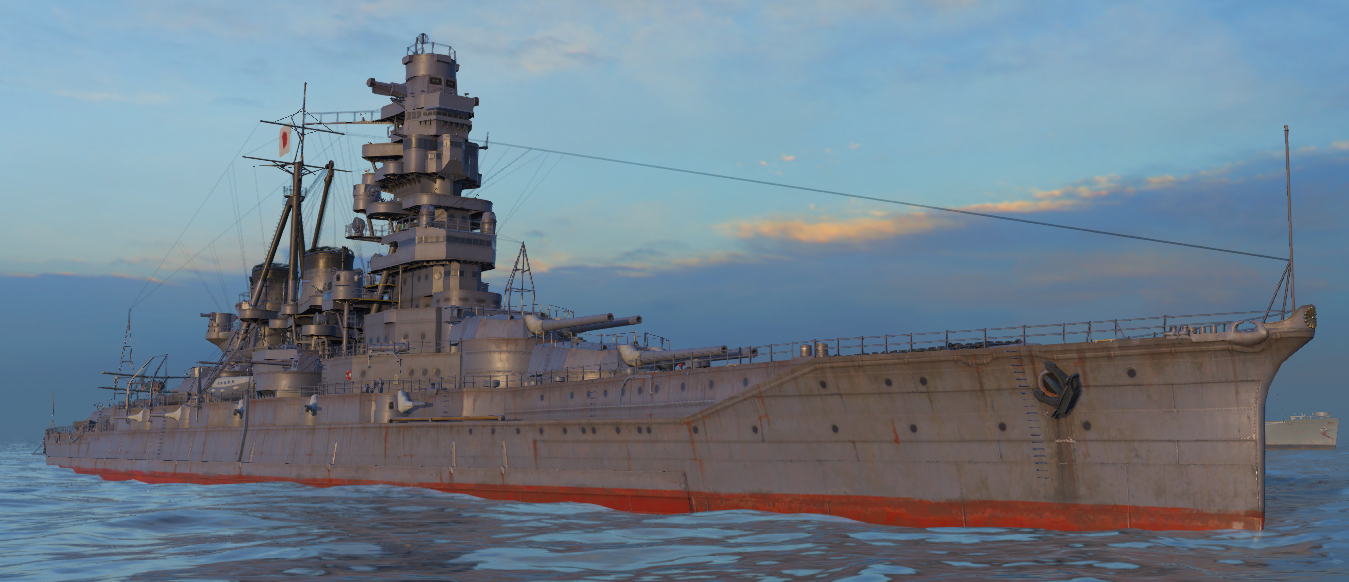
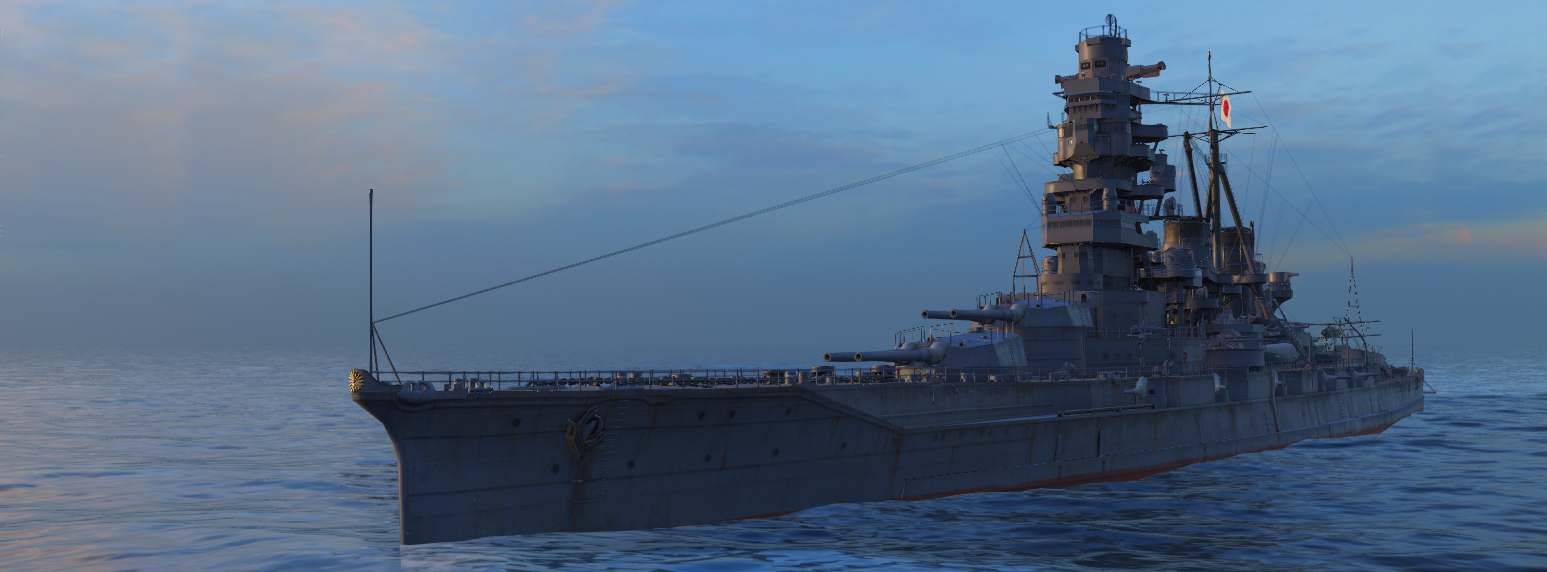
WoW’s renditions of the Kongo
This pattern of building around the trip masts was repeated again on the following Fuso, Ise and Nagato, the latter having smaller but much more sturdy heptapodal masts. It should be added that the Kongo class AA battery and also constantly reinforced from this first refit to 1944 while their width was increased by the addition of massive ASW protection bulges. So just like the aforementioned Queen Elisabeth or Italian Duilio and Cavour classes, the Kongo were almost brand new untested ships in WW2. And fight they will in this epic struggle of the pacific…

Hiei off Tsukugewan on trials, 1938
The Kongo in action
Both ships were quite busy, patrolling off the Chinese and Korean coast in the 1930s, then from 1937, actively covering landings and operations at Shanghai and along the coast. From 1941, they were deployed in Guadalcanal, where three were sunk in action, notably by gunfire (see the ww2 actions section above). IJN Hiei, Kongo and Kirishima would pay a heavy price to this compaign, and IJN Haruna managed to survive until July 1945, to be sunk by aviation in Kure.
Specifications (1944)
Displacement: 36 600 t. standard -37 187 tonnes fully loaded
Dimensions: 220 m x 30,8 m x 9,7 m fully loaded
Propulsion: 4 propellers, 4 Parsons turbines, 11 boilers, 136 600 hp, top speed 30,5 knots, range 15,000 Km/26 knots
Armour: Belt 279 mm, turrets 227 mm, ammunition wells 101 mm, citadel 254 mm.
Armament: 8 x 356 mm (4×2), 16 x 152 mm barbettes, 8 x 127 mm AA, 118 x 25 mm Type 96 AA, 8 x 533 mm TTs, 3 Nakajima seaplanes.
Crew: 1437
Illustrations

Hiei 1932
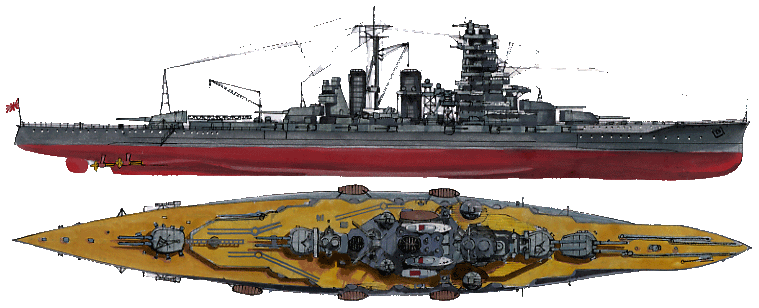
Kirishima in 1944
Fuso class battleships (1915)
Fuso, Yamashiro
These mighty dreadnoughts were in fact distant derivatives of the HMS Dreadnought in 1906. Their plans were first conceived in Japan, but they were not the result of previous experience, notably that of the Battle of Jutland in the west. The engineers, however, had worked on a ship approaching the speed of a battle cruiser, while having the classic protection of a dreadnought. To accommodate her enormous machinery, capable on plans, to deliver more than 25 knots, the hull was roomy.
IJN Fuso and Yamashiro were started in 1912 in Japan, launched in 1915 at Kure and Yokosuka and entered service in 1917. They were then the most powerful warships in the world, outclassing anything that floated so far, within the Royal or the US Navy, a true symbol of imperial ambitions in Asia. In terms of armament, these two Japanese Battleships conventionally arranged their artillery, derived from Vickers Armstrong models, in six axial twin turrets. This gave a them a powerful broadside salvo but limited hunt and retreat fire due to the central turrets very limited arc of fire. However, these two ships kept their secondary barbette guns for a long time, and their AA was at first, very limited.

The Fuso in 1941, with her impressive “pagoda”, highest bridge superstructure in the world.
Serious things will start around 1925 as new super-dreadnoughts were cancelled by Treaty, later converted as aircraft carriers. The reconstruction and overhaul of the Fuso started in 1930 and went on until in 1933, resumed in 1935 until 1937, and for Yamashiro, a single time, but from 1930 to 1935. These years were well used, to rebuild their machinery and change their boilers, resulting in a new silhouette, aft blockhouse, installation of catapult, housing for three on-board seaplanes, new rangefinders, new bridge with multiple utility decks and observation posts along the tripod, state-of-the-art optics, and a completely modern, powerful AA. The hull was also seriously enlarged with bulges to improve their underwater protection. In the end, this process made them reach 39,150 tons for a top speed maintained to 25 knots. However in 1939, despite their recent modernization, the two ships were considered ancestors. However fast and formidable, they formed a significant part of the naval forces of the Empire of Japan, then made up of three pairs: Fuso, Ise and Nagato, as well as the four Kongo.
Specifications
Displacement: 37,500 t. standard -39,700 t. Full load
Dimensions: 213 m long, 33.1 m wide, 9.7 m draft (full load)
Propulsion: 4 propellers, 4 Brown Curtis turbines, 8 boilers, 75,000 hp, Maximum speed 25 knots -RA 15,000 km / 23 knots
Armor: Maximum (belt) 305 mm, turrets 305 mm, barbettes 204 mm, citadel 351 mm.
Armament: 12 x 14-in(356 mm) (6×2), 14 x 6-in(152 mm) in barbettes, 8 x 5-in(127 mm) AA, 95 x 25 mm Type 96 AA (1945), 3 Nakajima seaplanes.
Crew: 1550
Ise class battleships (1916)
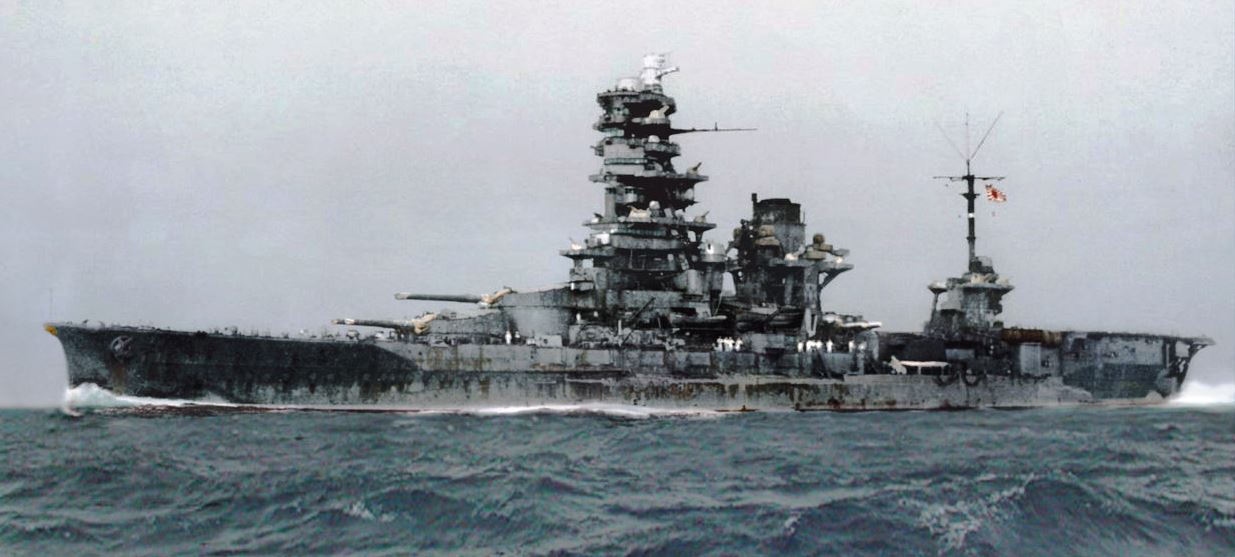
Ise class, IJN Hyuga during WW2
IJN Ise and the Hyuga were two fast dreadnoughts resulting from the experience gained with the two Fuso, the first battleships designed and built in Japan, albeit still with a strong influence of British engineering. They were launched in 1916 and 1917 and completed at the end of the First World War. To have the greatest firepower during the favorite “crossing the T” Japanese tactic, the Admiralty wanted to concentrate the firepower of twelve 356 mm guns (15 in) with all-axial twin turrets just as for the Fuso. Unlike HMS Agincourt, initially ordered by Turkey, Brazil and later requisitioned, Ise had three pairs of superimposed turrets, forward and aft and instead of having two at superstructure deck level either side of the second funnel like for the Fuso, this last pair was also superimposed and facing backwards. This configuration allowed a better concentration of armour as the ship was less “strecthed out” tahn the Fuso. Howevr so many openings for barbettes weakened the structural strength in torsion, but offered a better dispersion for the enemy artillery. The choice of triple or even quadruple turrets was made too, but urgency to complete the program won over lenglty developments on other turrets. There was also the fact a larger turret would have imposed also a wider hull, which went against the drive towards faster battleships, and ultimately a blending of types with the fast battleships designed for the 8-8 plan in 1918-1919.
The Ise class secondary artillery consisted in casemated 140 mm guns, 16 in all. Light artillery was limited to a few 75 mm (3 in) rapid fire guns to deal with TBs and aviation. There were also submerged torpedo tubes. Their bridge was staged around a solid tripod mast, soon to be fitted with secondary bridges and platforms until it was rebuilt as a solid bridge during the late interwar.
In 1926-28 indeed, both ships underwent many modifications, including a redesigned bridge, the addition of dual purpose 127 mm (5 in) twin turrets, seaplane catapults on fore and aft turret roofs. In 1934-37, the two ships were in dry dock again for their last round of modernization, quite radical. This overhaul including an enlarged hull fitted with anti-torpedo bulges, better compartmentalized internal protection, reinforced deck protections, better AA armament with twin and single 25 mm guns, submarine torpedo tubes and some barbettes removed (especially those at the rear, useless in heavy weather). The main artillery turret mounts were modified for better elevation and increasing their range. The powerplant was entirely modernized, with brand new oil-fired boilers, truncated exhausts into a single funnel while the bridge was “consolidated”, completely masking their original tripod support, fitted with numerous walkways and platforms for observation sights, projectors and AA guns. They gained speed, power and range, with a more capable armament served by modern rangefinders, ballistic computer and high-performance electro-optical instruments. A single catapult was kept, now installed on the upper central turret (‘C’), with three seaplanes in reserve.
When World War II broke out, IJN Ise and the hyuga participated in combat maneuvers, along with the rest of the naval group. Their first assignation was as a distant cover during the attack on Pearl Harbor. Because of their speed of 25 knots, they were like the Fuso quickly relegated to the second place. After Midway, the admiralty found it needed more aicraft carriers, and choose to partially convert these two ships, a little faster than the Fuso. The conversion was a long process, first of development and then practical reconstruction, not as aircraft but floatplane carriers. They were recommissioned at the end of 1943 with an aft flight deck in place of their two rearmost turrets (recycled in coastal defense works). Under it was built a central hangar with a single elevator, catapults and a dedicated crew to serve a full squadron of 14 Yokosuka D4Y torpedo bomber floatplane version and 8 observation plane Aichi E16A, so 22 in total. They also tested various floatplanes such as the A6M2-N fighters (seaplane version). Their AA light artillery was massively reinforced. As reborn, the twins took part in numerous exercises within the second battleship division. They also took part in a single large-scale operation, the Battle of Leyte, as part of Admiral Ozawa’s “bait fleet”, intended to attract Halsey northwards, leaving the souther-central sector of the Philippines open for the battlefleet (3nd division with Fuso and Yamashiro). The TF38 thrown no less than five air attacks, lasting several days. They sink many ships, but the Isa class at the end were practically the only survivors of the Ozawa fleet. Theu took refuge in Kure and stayed there ide because of the lack of fuel until the end of the war. Scuttled in August 1945, they were refloated and BU in 1947.

Author’s HD illustration of the Ise class in 1941

IJN Hyuga after conversion at Leyte in October 1944
Specifications (1941)
Displacement: 35,800 t. standard, 40,169 t. Full load
Dimensions: 215.8m long, 31.75m wide, 9.15m draft (full load)
Propulsion: 4 shafts Parsons turbines, 8 Kampon boilers, 80,000 hp, Top speed 25.3 knots
Armor: Maximum (belt) 300mm, turrets 300mm, ammo magazines 200mm, citadel 350mm.
Armament: 12 x 356 mm (6×2), 16 x 140 mm barbettes, 8 x 127 mm AA, 20 x 25 mm Type 96 AA, 3 Nakajima seaplanes.
Crew: 1370
 Nagato class battleships (1919)
Nagato class battleships (1919)
Nagato, Mutsu.

Mutsu camouflaged in Kure 1945 – colorized by Hirootoko Jr.
The last IJN dreadnoughts
The Nagato and Mutsu were the first battleship for Japanese, and among the most powerful “super-dreadnoughts” in the world at their entry into service. Marrying excellent protection, a remarkable speed for the time and the most powerful artillery of the moment, pieces of 406mm or 16 inches. They were a Nippon replica of British Queen Elizabeth. Their construction was approved in 1917, plans were made by Yuzuru Hiraga. Their hull was based on that of the Ise, but they had an upper edge in caliber and worn, in default of the volume of fire. This artillery was distributed in a very classical way in two groups of double turrets at the front and rear, in the axis. The pieces, actually displaying a 410mm caliber, were to form the base of the later plan ships of the 1918 plan, all later condemned by the Washington Treaty.
This artillery was supplemented by a secondary armament in barbettes, twenty pieces of 140mm, and eight submarine torpedo tubes, 533mm, and four pieces of 76mm for air defense. The protection was of the “all or nothing” type, protecting the vital parts of the ship. The bridge was characterized by a heptapod mast (seven feet), considered significantly superior to the conventional tripods used in most navies. They were needed to accommodate all the bridges and hunes, on a pagoda-like level. With time, these bridges widened and completely drowned the carrier masts, becoming a single massive superstructure.
During their major overhaul in 1934-36, the Nagato and Mutsu (launched in 1919 and completed in 1920-21) received a new turbine engine more powerful (10 oil boilers instead of 21 mixed), a modified supertructure, large anti-torpedo bullets with a triple hull, and an antiaircraft armament comprising four 76mm double turrets, and 10 double 25mm double hulls, at the cost of sacrificing two barbettes.
Subsequently the two ships were frequently flagship of the squadrons, actively participating in operations in China in 1937, and maneuvers and wing exercises in the First Battle Division. In December 1941, the Nagato was the flagship of Admiral Isoroku Yamamoto, at the head of the Assault Squadron to Pearl Harbor. He was then present at the battle of Midway, then won Truk and Opera on the side of Lingga. The Nagato took part in Operation A Go against the Mariana Archipelago, and took part in the Battle of the Philippine Sea. Then in October, he participated in the battle of Leyte, more precisely in the engagement of the Sibuyan Sea. He was attacked by Douglas Dauntless of the Navy who inflicted serious damage to him, then was engaged to Samar, cannonading the American Task Force (Taffy 3), but put to flight by the destroyers shortly after their success against the Haruna.
This was his last major commitment. The Nagato was in Japan in 1946, but was not sunk. He was captured by US forces (the last Nippon battleship still afloat), and completed his career during the Bikini Atoll tests in 1946 (Operation Crossroads). Her hull is still lying on the place of the explosion. A life-size replica of the bridge and a bridge was built for the film Tora Tora Tora (1968). Mutsu, on the other hand, was part of the attacking Pearl Harbor squadron, then was engaged at Midway, before embarking on a long time at anchor, including at Truk. It was destroyed as a result of an accidental explosion in June 1943.

Author’s HD profile illustration of the Nagato
Specifications
Displacement: 37,800 t. standard – 42,300 t. Full Load
Dimensions: 221 m long, 34.59 m wide, 9.50 m draft (full load)
Propulsion: 4 propellers, 4 Parsons turbines, 10 Kampon boilers, 80,000 hp, Maximum speed 27 knots
Shielding: Maximum (belt) 305 mm, turrets 508-356 mm, ammunition magazines 130 mm, citadel 350 mm.
Armament: 8 x 406 mm (4×2), 18 x 140 mm barbettes, 8 x 127 mm AA, 20 x 25 mm Type 96 AA (96 1944), 3 seaplanes Nakajima.
Late Interwar studies
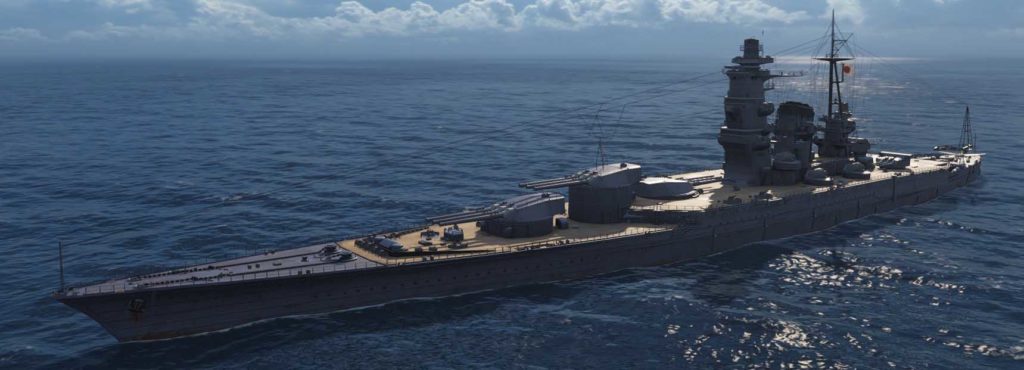
IJN “Izumo” (wow’s rendition, fake name), one of the draft designs for a “super battleship” concept preceding the Yamato-class, featuring heavy armor, good top speed and her main battery guns entirely forward, reminiscent of the British Nelson and other projected designs during the post-Washngton period.
Yamato class battleships (1941)
IJN Yamato, Musashi, Musashi, unnamed.
The last IJN battleships
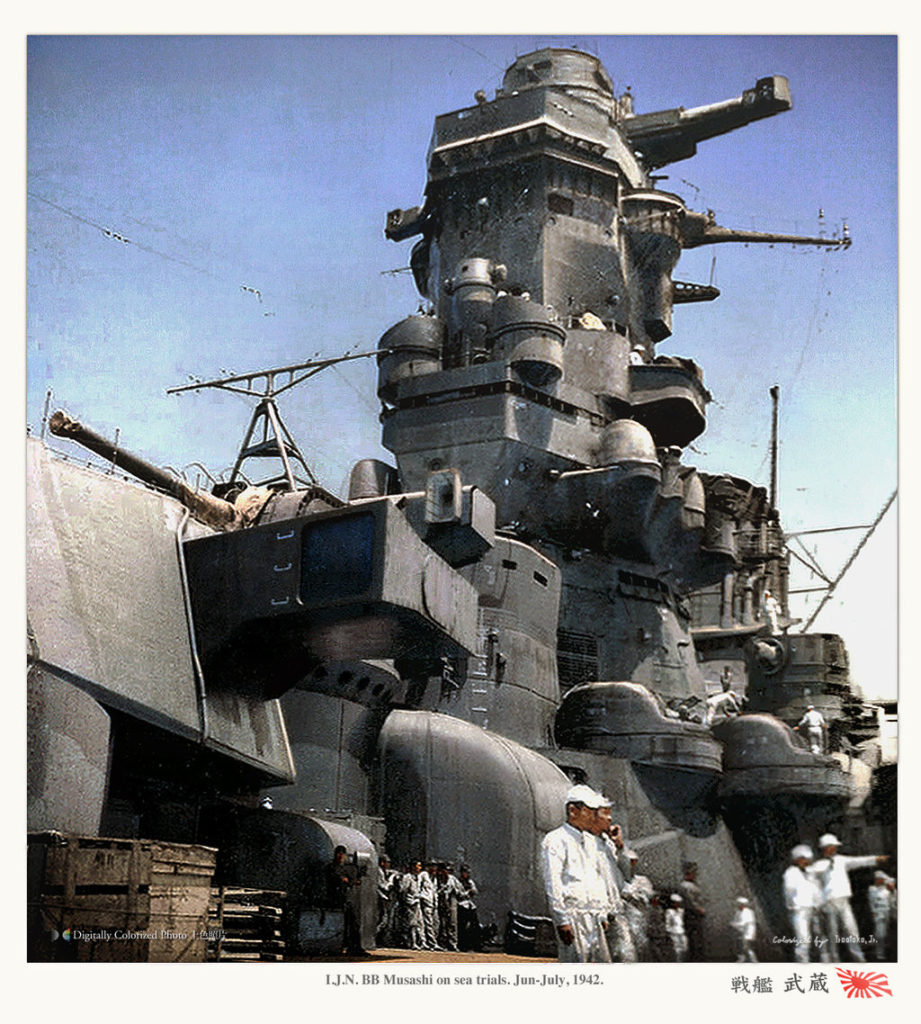
IJN Yamato, like Bismarck, is the subject of a post-war myth. Mysterious because classified highly secretive, it was known only by name by the US secret service in 1941 when it entered service. It still fascinates and is the subject of a relatively recent Franco-Japanese underwater expedition, as well as a quantity of books and a film in 2005 in Japan, “The men of Yamato”. He has definitely become an icon in today’s Japanese culture.
In fact, the Yamato was the leading ship in a series of four “new generation” fast battleships, part of a massive naval rearmament plan begun in 1937. The Yamato (the former name of Japan) was literally designed around its main artillery, extremely massive, because for the first time it includes 18-inch (457mm) pieces, while the average caliber of the battleships of the time ranged between 330 and 406mm. This caliber had been banned by the Washington Treaty in 1922, anxious to avoid escalation, but had since slept in the cartons of the admirals.
The only building in service – for a short time – with such artillery, had been the Furious battle cruiser, in 1917. Initially provided with two simple turrets, quickly reduced to one while the rear deck was converted for the first time. aviation. The Yamaot, meanwhile, lined up nine guns, divided into three triple turrets, a configuration that saved space and made it possible to optimize protection. This unparalleled artillery in the world (each turret weighed the weight of a destroyer), carried to 40 kilometers, then largely out of reach of battleships in service. To control the shooting, the battleship had a squadron of 7 seaplanes, lodged and launched from behind. But this theoretical impunity was doubled by a protection equally unparalleled.

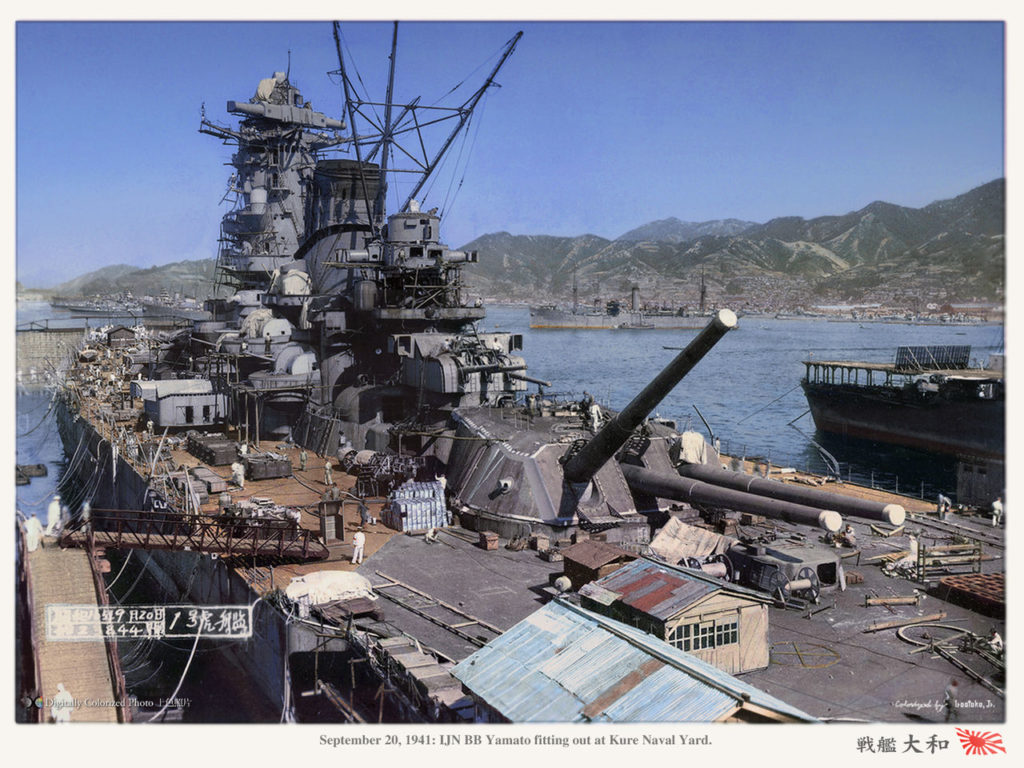
Yamato completed in Kure in September 1941.
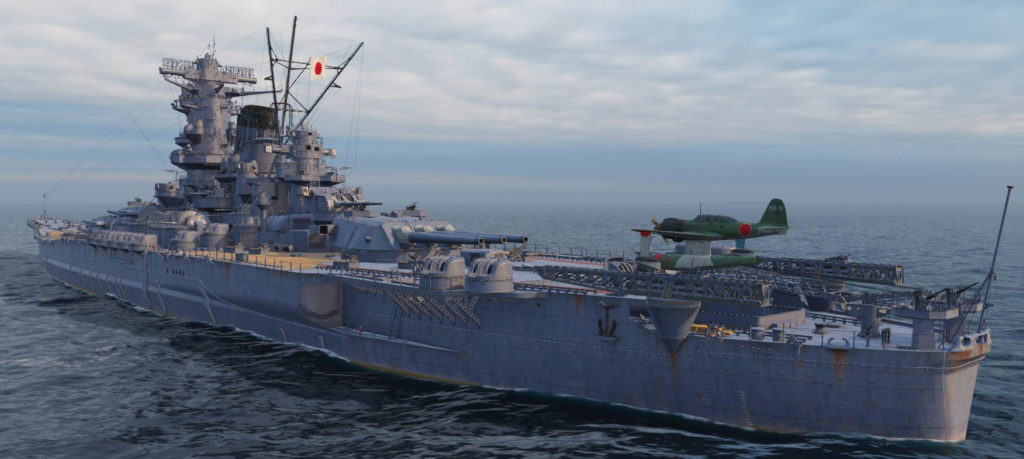
wow’s rendition of the Yamato, stern view
To increase this protection, the hull was enlarged to nearly 40m, the weight of the total shielding being more than 20,000 tons. In fact, despite a length lower than the Iowa of 1943 (270 meters), the Yamato class ships set a tonnage record for a military ship unmatched at the time, and will remain so until 1960 with the launch of the door nuclear USS Enterprise aircraft (80,000 tons). This shield, both external and lined with internal formwork was sufficient to withstand several 406mm impacts, the standard artillery of American battleships.
The Yamato was started in Kure in a basin specially designed for its size, in November 1937. Throughout its construction, a huge camouflage net covered the shape. The engineers working on the project had only a partial view of it and did not know how to participate in such a large project. Every night plans were sealed in a safe. In August 1940, finally, the building was launched, without any ceremony to keep the secret. The American secret services knew then of it but thought they had to make a ship equivalent to theirs at best.
The class consisted of four buildings. The Yamato, commissioned after Pearl Harbor, was followed by Musashi (In service in August 1942). The other two were to follow during the war, but manpower and materials needed, only the first one could be finished. Bearing the name of Shinano, he will be on active service in November 1944, rebuilt into an armored carrier. Despite their extraordinary potential, the two battleships of the Yamato class were relatively underemployed:
The Yamato became the flagship of Yamamoto Isoroko from February 1942, and will be replaced in this role by Musashi. He will conduct wing exercises but will be out of action, remaining anchored at Truk until the end of 1943, and then won Kure for dry dock maintenance. During this period, his anti-aircraft artillery will be singularly reinforced. In 1944, he had nearly 80 pieces of 25mm. During his return trip to Truk he will be torpedoed by the USS Skate.
The damage will be enough to require repairs that will immobilize it until April 1944. During this period, two 155mm turrets were sacrificed to add additional anti-aircraft guns. In June, he will participate in the Battle of the Philippine Sea, and in October, at the Battle of Leyte, where he sank the USS Gambier Bay, while being held at bay by the action of the US escort destroyers. A USS Franklin Helldiver managed to place a bomb on his deck before, and the Yamato withdrew for repairs.
From November 1944 to March 1945 he returned to Kure, sinking into inaction while his AA artillery was further strengthened. It was during this period of inaction that the sailors nicknamed him “Yamato Hotel” with frustration. However, on March 19, he will be attacked without serious damage by TF58. Then in April 1945, with the situation that degenerated in Okinawa he was mandated for the operation “Ten-Go”.
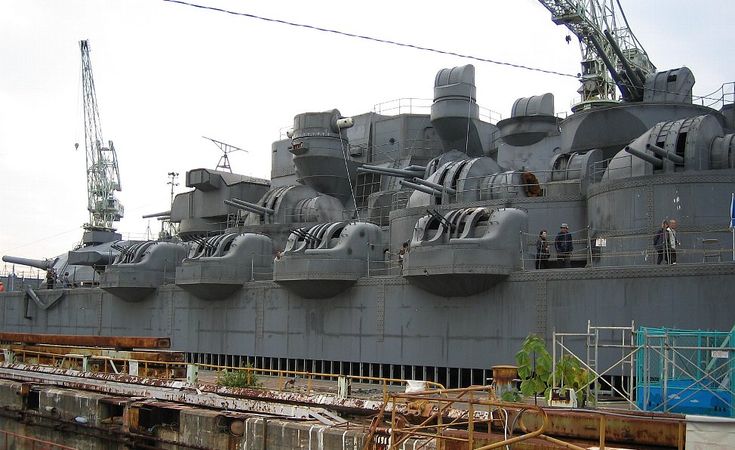
It was a suicide mission (attacking the landing fleet, then stranding to serve as an improvised coastal battery) because there was not enough fuel oil for the return. On April 7, he was spotted and intercepted by the TF58, which launched no less than 582 aircraft. During an apocalyptic and uneven fight, he received rockets and bombs from the Helldivers (8 made fly) and 13 Avenger torpedoes. He was cut in two by a huge explosion at 2:20 pm and sank shortly after, carrying the bulk of his crew into death. There were only 269 survivors.
The Musashi took longer to finish: The plans were modified along the way following requests from the navy. The lateral armor of the turrets was reinforced, and the communication system modernized. From August 1942 he joined Truk, where he bore the mark of Admiral Yamamoto. He returned to Japan in an official trip with his ashes for the ceremony that was to follow after his death in April 1943. Returned to Truk, he made an exit on March 29 during which he was torpedoed by the USS Tunny.
She had to return to Kure for repairs. Two 155mm triple turrets were disembarked and replaced during this work in dry dock by new 25mm carriages. Back in action, he wore the mark of Vice Admiral Kurita during the Battle of the Gulf of Leyte. Towards the end of the engagement, he was attacked by hundreds of aircraft of the 3rd fleet. Containing 18 bombs and 20 torpedoes, he will eventually turn around and sink. There were however more survivors (around 1900) than for the ill-fated Yamato.

Author’s HD profile illustration of the Yamato in 1945
Specifications
Displacement: 62,300 t. standard – 72,800 t. Fully loaded
Dimensions: 263 m long, 37 m wide, 10.40 m draft (full load)
Propulsion: 4 shafts steam turbines, 12 Kampon boilers, 150,000 hp, Maximum speed 27 knots
Armour: Maximum (belt) 409 mm, 650 mm turrets, ammunition magazines 350 mm, 200mm bridge, citadel 600 mm.
Armament: 9 x 457 mm (3×3), 12 x 155 mm (4×3), 12 x 127 mm AA (6×2), 24 x 25 mm Type 96 AA (115 in 1945), 8 x 13 mm AA, 6 seaplanes (miscellaneous).
Crew: 2750
A150 “Super-Yamato” class battleships (1942)
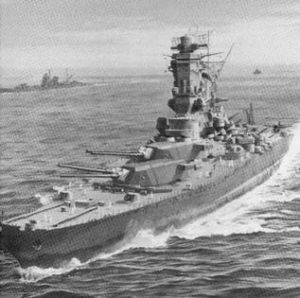
The Imperial Japanese Navy recognized from 1896 already it did not had the industrial capacities to out-produce their potential adversaries, notably the UK and USA. The admiralty knew the only solution was to be quality, and the new designs were to be more powerful than the competition. This qualitative lead was maintained for 40 years and each time, the Kongo-class battlecruisers to the the Nagato-class battleships it was always true. Again in the 1930s the numerous studies leading to the final Yamato-class design was perhaps the epitomy of this. The A-150s sticked to that doctrine, but with a step ahead of the possible competition in a decade and a half. Logically, they were to out-do even the Yamato design.
Early studies as a prelude to the A-150 battleship development program called for eight/nine 510 mm guns or 20 inches twin or triple turrets, since there was already a 480 mm (18.9 in) experimental gun tested in 1920–1921 which gave the Japanese confidence in just up-scaling a bit these guns. Designers hoped to maintain also the same top speed of 30 knots (56 km/h; 35 mph), knowing that at the time, the best, latest USN battleships designs were capable only of 27-knot (50 km/h; 31 mph): The North Carolina class. Specifications were curtailed later as on paper, displacement calculation gave a standard displacement of no less than 91,000 metric tons (90,000 long tons), and the admiralty was not sure this design “too large and too expensive” would be adopted and ratified by the diet (parliament).
Formal design studies however started in 1938–1939, downgraded to a slightly larger Yamato class, which plans were just completed, and the artillery was down to six 510 mm in three twin turrets. The Japanese insisted on this point, fearing US intelligence would have some clues soon or later on the Yamato class’s 18-in guns and would prepare a counter-design of their own. The 510 mm had the advantage of out-ranging anything built or projected for the years to come.
Plans were completed in early 1941. But ordered did not come, as the Yamato class was already in completion in the largest basins available. Later, after Midway, priorities of the naval staff changed radically and priority was given to aicraft carriers, and later smaller ships for ASW warfare.
Two of these battleships were eventually given a provisional designation, Number 798 and 799, FY1942 program. The same dock used by the Shinano and Kure (fourth Yamato-class) respectively. The Completion estimates were 1946–1947.
The design was postponed indefinitely until documentation was lost, burnt in the bombings of 1945. Therefore no plans survived and further destruction of records before or at the start of the US occupation of Japan limited the amount of information available to historians. Everthing concerning the A-150’s specifications are speculative and open to debate. “Reasonable assumptions” gave a displacement similar to the Yamato class, about 70,000 metric tons with a 457 mm belt armor, which reached the limit of what Japanese steel mills in Japan were capable to manufacture. Two layers of lighter armor plates were welded together despite the lower effectiveness of this solution.
Also speculative, the A-150 design was to be given a main battery of six 510 mm/45 guns in three twin turrets, the largest ever fitted to a capital ship, even compared to the already impressive 18-in guns of the Yamato class. Historians William H. Garzke and Robert O. Dulin’s concluded that these paper project, if realized, would have been without doubt the “most powerful battleships in history”. In 1941, development work on the 20-in gun ended with the manfucature of at least one cannon at the Kure Naval Arsenal. The turrets were designed quite precisely around them, giving them space to avoid shell interference. Each turrets was the equivalent of a destroyer in weight: 2,780 metric tons (2,740 long tons). The gun barrels themselves weighted 227 metric tons, protruding 23.56 meters (77 ft 4 in) in and out of the turret, with a bore length of circa 22.84 meters (74 ft 11 in), firing 1,950 kg (4,300 lb) AP shells.
The secondary armament remains unknown, and Historians Eric Lacroix and Linton Wells made an educated guess of a battery of the new 100 m (3.9 in) Type 98 DP guns, perhaps 24 turrets. These guns reached a ceiling of 11,000 meters (12,030 yd), and 14,000 meters in surface fire, a 1,030 m/s (3,400 ft/s) velocity, at 15-19 rpm, however these were susceptible to wear down the barrels quickly. The rest was comparable to the Yamato, a large number of 25 mm guns in quad, triple, twin and single mounts.
B65 project battleships (1942)
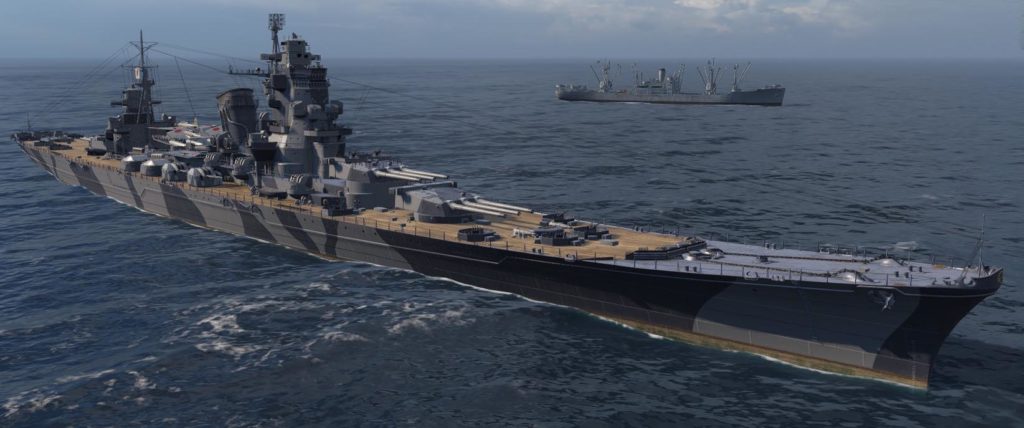
What-if rendition of the B-64 by world of warships, where the B-64 is flagged as a heavy cruiser
Conflicting Denominations
The “B64 type” is reported by Conway’s in its capital ship section in the 1990s edition. However in the new one, and now on the updated wikipedia page it is reported as B65 type, “Super Type A cruiser”, and was a kind of intermediate between a battleship and a heavy cruiser. It was studied in 1940 initially as a “cruiser killer”. It seems the ships pre-date the Alaskas class, while the project regained interest and construction was proposed in January 1941, after the US announcement of the Two-Ocean Navy Act including the Alaskas. There were conflicting infos between the old Conway’s book and Lacroix’s book about the denomination and specs.
It was called “Super A” cruiser (page 608 in Lacroix’s book). For Lacroix it was rather the B65 (The B64 was the Amagi), known by Naval General Staff designation V-16 and the first ships of the class designated no.795 and 796. It seems also they were armed with six twin 14-in (and not 14.2-in) guns rather than 3×3 12.2 in as reported by Conways in its 1990s edition. But as for the “super-yamato” ntohing survived as for a documentation, both blueprints and specs? This is left to much speculations among historians.
Design development
The concept of the Type A super-cruiser finds its origin in the decisive battle strategy pushed by the IJN, which in 1936, formed the Night Battle Force (Yasen Butai). This force was to attack the enemy’s outer defense ring of cruisers and destroyers, at night. After this outer ring was done for, IJN cruisers and destroyers would launch torpedo attacks on battleships, negating the enemy’s (by then most likely the US Pacific Fleet) superiority in capital ships. What remained of the fleet was finished-off by IJN’s main battleship line the following day. The IJN assigned one division of fast battleships/battlecruisers for backup to this unit and at first the Kongō-class battlecruiser were assigned, upgraded as fast battleships. However the IJN nava staff planned to replace them with four heavy, “super” cruisers. In 1936, they were desfined as the B-65 cruisers. Their main characteristic was to would mount 310 mm (12.2 in) guns and an armour able to resist 203mm (8 in) AP shells, while being able to rech 40 knots. The “super-A-class cruisers” were placed above in the hierarchy to the “A-class ships”, the designation for heavy cruisers.
Plans were finalized in Circle Five and Circle Six warship construction planning, 7 January 1941. Six B-65s were to be ordered two batches, the first two in Circle 5 and remainder in Circle 6. In between the US Two-Ocean Navy Act was learnt and Alaska class in it, so on 5 September 1940 order came as the IJN feared these USN super cruisers would be part of the “outer ring” and American battle fleet’s wartime screen. Therefore, the B-65s were became a class designed to counter them and the design revised accordingly.
Design of the B-65
Design work started in 1939 and preliminary plans completed by September 1940. However meanwhile, tests of the lower (ASW) protection went on, to deal with pluging shell fire and torpedoes, while main armament preliminary tests went on in 1941. Plans called forbasically a scaled-down version of the Yamato-class battleships, stating a “clipper bow, flush-deck construction, and a generally similar superstructure”. Primary armament (apparently changed in January 1941) called for nine 310 mm (12.2 in)/50 caliber guns in three triple turrets, so basically repeating the Yamato’s configuration. Also sixteen 100 mm (3.9 in)/65 Type 98 DP dual mount guns were in the superstructure, and 12 twin Type 95 25 mm (1 in) AA guns, plus four 13.2mm Hotchkiss HMG. The main turrets were estimated weighting around 1,000 long tons, in which 350 long tons were used for armor alone, but no blueprints susrvived to confirm this.
Protection by a 190 mm (7.5 in) belt armor, sloped at 20°, combined with 125 mm (4.9 in) of deck armor formd the main above waterline protection. The geared turbine sets individually would have been capable of 42,500 shp, reaching a total of 167,674 shp for an estimated 34 kn (39 mph; 63 km/h) on hypothetical trials with forced heat, whereas the designe speed was of 33 knots. It was still a far cry to the 40 knos initial design. Also, to answer the Alaska armed by 12.0 in guns, an alternative proposal went for six 356 mm (14 in) in twin turrets instead, while the armor protection was increased to resist 12 in shells. Displacement would have been by then 40,000 long tons with a reduction in performance. In the end, this alternative design was rejeted by the IJN.
Final design & cancellation
In 1941 however, the situation started to chage rapidly for the IJN which started to lean towards aircraft carriers and auxiliary vessels, meanwhile the IJN concentrated more on Circle Three and Four construction programs. Therefore circle five was delayed, and after the fateful Battle of Midway in June 1942, Circle Five planning was completely revised and Circle Six postponed again. New circle five called forthe two B-65 battleships and their hull numbers 795 and 796. Projected commissioning dates were 1945 and 1946. Of course by 1944, strategic requirements delayed them further, and definitive construction plans were never finalized, and no contracts placed.
Specifications (Conway’s 1990s)
Displacement: 32,000 t. standard – 34,800 t. Fully loaded
Dimensions: 244.6 m long/802 ft (240 m wl), 27.2 m/89 ft bream, 8.8 m/28 ft draft (full load)
Propulsion: 4 shafts geared steam turbines, 8 Kampon boilers, 160,000 hp, Top speed 33 knots, oil 4545 tons
Armour: Belt 7-1/2 inches (183 mm), decks 5 in (127 mm)
Armament: 9 x 12.2 in/310 mm (3×3), 16 x 155 3.9 in/100mm AA (8×2), 12 x 25 mm Type 96 AA, 8 x 13.2 mm AA, 8 x 24 in TTs, 3 seaplanes.
Crew: Unknown
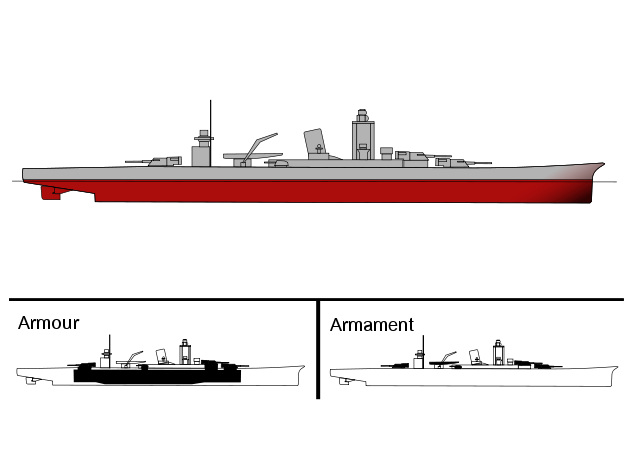
Design B-65 schematics.
Specifications (Lacroix)
Displacement: 31,905 t. standard – 35,000 t. Fully loaded
Dimensions: 246.2 m long/808 ft, same
Propulsion: same but 170,000 hp (167,674 shp)
Range: 8,000 mi (13,000 km) at 18 kn (21 mph; 33 km/h)
Armour: Belt: 190 mm, Barbettes: 190-210 mm, CT 180 mm, Deck: 125 mm
Armament: same
Crew: Unknown
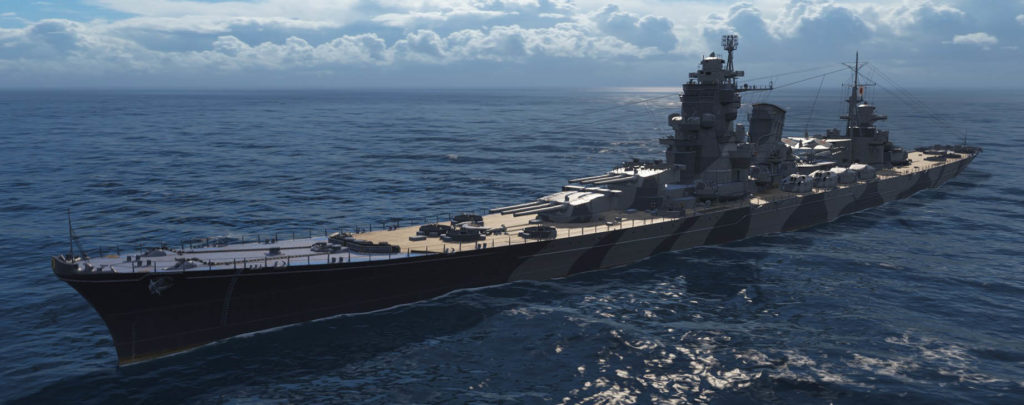
wow’s rendition of “Adzuma”, of the B64 class
Notes: According to Conway’s 1922–1946, p. 178, “Super Type A cruisers” were heavy cruisers, but still in the capital ship, not cruiser section. Garzke and Dulin in Battleships: Axis and Neutral Battleships in World War II, p. 86, states they “would have satisfied every basic characteristic of the battlecruiser type.” The Alaska-class cruisers were based on mistaken intelligence reports about IJN “super cruisers” superior to US 8 in-armed heavy cruisers (Gardiner & Chesneau, p. 122, Pike, John “CB-1 Alaska Class”.


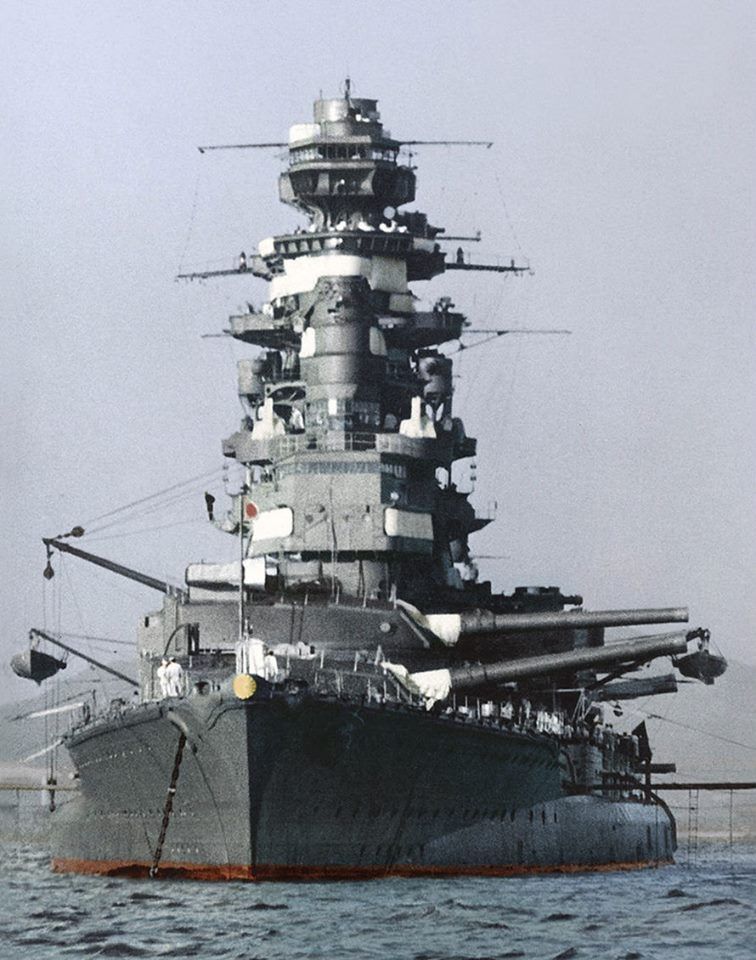
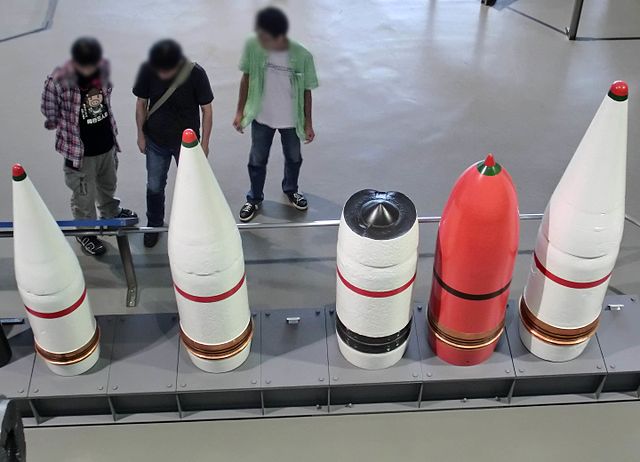
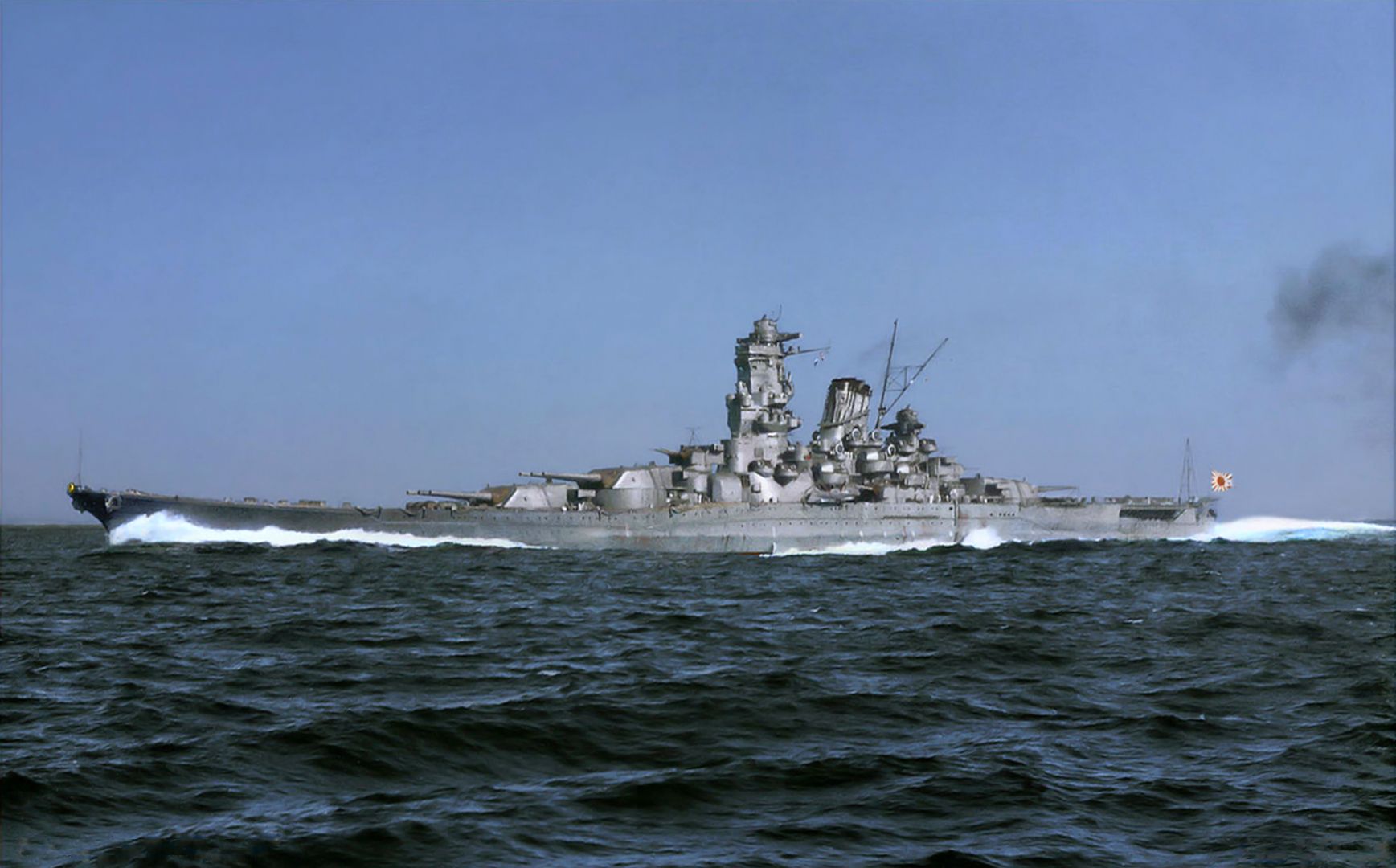
 Latest Facebook Entry -
Latest Facebook Entry -  X(Tweeter) Naval Encyclopedia's deck archive
X(Tweeter) Naval Encyclopedia's deck archive Instagram (@navalencyc)
Instagram (@navalencyc)





 French Navy
French Navy Royal Navy
Royal Navy Russian Navy
Russian Navy Armada Espanola
Armada Espanola Austrian Navy
Austrian Navy K.u.K. Kriegsmarine
K.u.K. Kriegsmarine Dansk Marine
Dansk Marine Nautiko Hellenon
Nautiko Hellenon Koninklije Marine 1870
Koninklije Marine 1870 Marinha do Brasil
Marinha do Brasil Osmanlı Donanması
Osmanlı Donanması Marina Do Peru
Marina Do Peru Marinha do Portugal
Marinha do Portugal Regia Marina 1870
Regia Marina 1870 Nihhon Kaigun 1870
Nihhon Kaigun 1870 Preußische Marine 1870
Preußische Marine 1870 Russkiy Flot 1870
Russkiy Flot 1870 Svenska marinen
Svenska marinen Søværnet
Søværnet Union Navy
Union Navy Confederate Navy
Confederate Navy Armada de Argentina
Armada de Argentina Imperial Chinese Navy
Imperial Chinese Navy Marinha do Portugal
Marinha do Portugal Mexico
Mexico Kaiserliche Marine
Kaiserliche Marine 1898 US Navy
1898 US Navy Sovietskiy Flot
Sovietskiy Flot Royal Canadian Navy
Royal Canadian Navy Royal Australian Navy
Royal Australian Navy RNZN Fleet
RNZN Fleet Chinese Navy 1937
Chinese Navy 1937 Kriegsmarine
Kriegsmarine Chilean Navy
Chilean Navy Danish Navy
Danish Navy Finnish Navy
Finnish Navy Hellenic Navy
Hellenic Navy Polish Navy
Polish Navy Romanian Navy
Romanian Navy Turkish Navy
Turkish Navy Royal Yugoslav Navy
Royal Yugoslav Navy Royal Thai Navy
Royal Thai Navy Minor Navies
Minor Navies Albania
Albania Austria
Austria Belgium
Belgium Columbia
Columbia Costa Rica
Costa Rica Cuba
Cuba Czechoslovakia
Czechoslovakia Dominican Republic
Dominican Republic Haiti
Haiti Hungary
Hungary Honduras
Honduras Estonia
Estonia Iceland
Iceland Eire
Eire Equador
Equador Iran
Iran Iraq
Iraq Latvia
Latvia Liberia
Liberia Lithuania
Lithuania Mandchukuo
Mandchukuo Morocco
Morocco Nicaragua
Nicaragua Persia
Persia San Salvador
San Salvador Sarawak
Sarawak Uruguay
Uruguay Venezuela
Venezuela Zanzibar
Zanzibar Warsaw Pact Navies
Warsaw Pact Navies Bulgaria
Bulgaria Hungary
Hungary

 Bundesmarine
Bundesmarine Dutch Navy
Dutch Navy Hellenic Navy
Hellenic Navy Marina Militare
Marina Militare Yugoslav Navy
Yugoslav Navy Chinese Navy
Chinese Navy Indian Navy
Indian Navy Indonesian Navy
Indonesian Navy JMSDF
JMSDF North Korean Navy
North Korean Navy Pakistani Navy
Pakistani Navy Philippines Navy
Philippines Navy ROKN
ROKN Rep. of Singapore Navy
Rep. of Singapore Navy Taiwanese Navy
Taiwanese Navy IDF Navy
IDF Navy Saudi Navy
Saudi Navy Royal New Zealand Navy
Royal New Zealand Navy Egyptian Navy
Egyptian Navy South African Navy
South African Navy






























 Ukrainian Navy
Ukrainian Navy dbodesign
dbodesign